

|
| articles | forbidden stories I-State Lines resources my hidden history reviews | home | |||||||||||||||||||||||||||||||||||||||||||||||||||||||||||||||||||||||||||||||

Writing/Film Dear Aspiring Writers: The Worst Advice You'll Ever Read A Literary Look at I-State Lines Spirited Away: Decay and Renewal An American Poem (Robinson Jeffers) Taoist Chinese Poems The Nelson Touch "It's all about oil, isn't it?" Kurosawa's High and Low A Bountiful Mutiny Howl's Moving Castle Thailand's Iron Ladies Trois Colours: Red The Thin Man: Thoroughly Modern Movies Why My Book Is Better Than the DaVinci Code Iranian Films: The Mirror 9 more in archive Recommended Books American Identity Hapas: The New America Can You Tell What I am? Part I Can You Tell What I am? Part II Only in America Self-Reliance Your Tattoo in 50 Years The American House and Frank Lloyd Wright Cultural Commentaries On Hatred and Anti-Americanism Anti-Americanism Part 2 Anti-Americanism Part 3 French-Bashing Germany: We All Have Problems, But... Kroika! Chronicles This Blog Sells Out Doom and Gloom Sells The Kroika Mascot-"Auspicious Pet" Wal-Mart and Kroika Kroika and Starsbuck Take a Hit Kroika Ad 1 Kroika Ad 2 Kroika Ad 3 Kroika Ad 4 Kroika Makes Bid for Oreo (April 1) Unfolding Crises: Asia China: An Interim Report Shanghai Postcard 2004 Corruption and Avian Flu: China's Dynamic Duo Exporting the Real Estate Bubble to China Is the Bloom Off the China Rose? China Irony: Steel, Marx & Capital Curing The U.S. and China's Dysfunctional Relationship China and U.S. Inflation Trade with China: Making Out Like a Bandit Whither China? Will the Housing Bust Take Down China? 8 more Battle for the Soul of America Katrina, Vietnam, Iraq: National Purpose, National Sacrifice Is This a Nation at War? A Nation in Denial Why Is This Such a Tepid Time? That Price Isn't Cheap, It's Subsidized U.S. Fascists Seek Ban on Cancer Vaccine The Truth About Christmas American Dream or American Nightmare? The Most Hated Company in America 2006 Sea Change Obesity and Debt Immigration Ironies U.S. Healthcare: Working Toward a Real Solution A Drug Industry Running Amok 10 more Financial Meltdown Watch What This Country Needs Is a... Good Recession Are We Entering the Next Age of Turmoil? Why Inflation Appears Low Doubling Down on 5-Card No-See-Um A Rickety Global House of Cards Are Japan and Germany Truly on the Mend? Unprecedented Risk 2 Could One Rogue Trader Bring Down the Market? Worried about Inflation? Stop Measuring It Economy Great? Bah, Humbug Huge Deficits and Huge Profits: Coincidence? Who's The Largest Exporter? Three Snapshots of the U.S. Economy Loaded for Bear Comparing Nasdaq to Depression-Era Dow Who's Buying Treasury Bonds? And Why? Derivatives: Wall Street Fiddles, Rome Smolders Financial Chickens Coming Home to Roost Is the Stock Market on the Same Planet as the Economy? The Housing-Recession-Oil-Healthcare Connection Could We Have Deflation and Inflation At the Same Time? What We Know, What We Can Safely Predict 31 more Planetary Meltdown Watch The Immensity of Global Warming Sun Sets on Skeptics of Global Warming Housing Bubble Watch Charting Unaffordability A Monster of a Housing Bubble A Coup de Grace to the Economy Hidden Costs of the Housing Bubble Housing Bubble? What Bubble? Housing Bubble II Housing Bubble III: Pop! Housing Market Slips Toward Cliff Housing Market Demographics Housing: Catching the Falling Knife Five Stages of the Housing Bubble Derailing the Property Tax Gravy Train Bubbling Property Taxes Have You Checked Your Property Taxes Recently? Housing Bubble: Where's the Bottom? Housing Bubble: Bottom II The Housing - Inflation Connection The Coming Foreclosure Nightmare 1 How Many Foreclosures Will Hit the Market? Housing Wealth Effect Shifts Into Reverse Housing Bubble Bust Will Take Down the Global Economy The New Road to Serfdom: A Negative-Equity Mortgage The Housing-Savings-Recession Connection After the Bubble: How Low Will It Go? After the Bubble: Rents and Housing Values Why Post-Bubble Rents Matter After the Bubble: How Low Will We Go, Part II Housing: 10% Decline May Trigger Financial Ruin How to Buy a $450K Home for $750K Inflation and Housing: Calculating the Bust The Growing Financial Risks of the Housing Bubble Construction Defects: The Flood to Come? Construction Defects Part II Who Gets Hammered in the 2007 Housing Bust Real Estate Bust: The Exhaustion of Debt What Happens When Housing Employment Plummets? One More Hole in the Housing Bubble: Insurance Financial Kryptonite in a "Super-Strength" Housing Market Three Secrets to Unloading Property Today 10 more Oil/Energy Crises Whither Oil? How much Is a Gallon of Gas Worth? The End of Cheap Oil Natural Gas, Naturally High Arab Oil Money and U.S. Treasuries: Quid Pro Quo? The C.I.A., Oil and the Wisdom of Crowds The Flutter of a Butterfly's Wings? A One-Two Punch to a Glass Jaw Running Out Of Oil vs. Running Out of Cheap Oil 2 more Outside the Box How to Make a Favicon Asian Emoticons In Memoriam: Winky Cosmos The Wheeled Vagabonds Geezer Rock Overload Paying for Web Content In a Humorous Vein If Only Writers Had Uniforms Opening the Kimono Happiness for Sale: Jank Coffee Ten Guaranteed Predictions for 2010 Why My Book Is Better Than the DaVinci Code My Brand Management Stinks Design Follies The New Jank Coffee Shop Jank Coffee, Upscale Tropic Style One-Word Titles Complacency Nostalgia Lifespans Praxis Keys to Affordable Housing U.S. Conservation & China Steve Toma, Me & Skil 77s: 30 years of Labor Real Science in the Bolivian Forest Deforestation and Sustainable Forestry The Solar Economy (book) The Problem with Techno-Fixes I Love Technology, I Hate Technology How To Blow off Web Ads and More 2 more Health, Wealth & Demographics Beauty of the Augmented (Korean) Kind Demographics and War The Healthiest Cold Cereal: Surprise! 900 Miles to the Gallon Are Our Cities Making Us Fat? One Serving of Deception Is Obesity an Inflammatory Response? Demographics & National Bankruptcy The Decline of Europe: A Demographic Done Deal? Are the Risks of Obesity Overstated? Healthcare: Unaffordable Everywhere Medication Nation The New Disease We Just Know You've Got Can You Can Tell Which Pill Is Fake? 2 more Landscapes Selling the Landscape The Downside of Density Building Heights and Arboral Roots Terroir: France & California L.A.: It's About Cheap Oil The Last Redwood Airport Walkabouts Waimea Canyon, Yosemite, Camping & Pancakes Nourishment The French Village Bakery Ideas What Is Happiness? Our Education System: a Factory Metaphor? Understanding Globalization: Braudel Can You Create Creativity? Do Average People Know More Than Their Leaders? On The Impermanence of Work Flattening the Knowledge Curve: The "Googling" Effect Human Bandwidth and Knowledge Iraqi Guangxi Splogs, Blogs and "News" "There is no alternative to being yourself" Is There a Cycle to War? Leisure, Time and Valentines Is the Web a Giant Copy Machine? Science Matters Anti-Missile Defense: Boost Phase Vulnerability History The Strolling Bones: Rock of Ages Bad Karma: Election Fraud 1960 Hiroshima: First Use All the Tea in China, All the Ginseng in America Friday Quiz Pet Obesity The Origins of Carbonara Organic Farms Oil and Renewable Energy Human Diseases Wine and Alzheimers Biggest Consumers of Chocolate 7 more Essential Books The Misbehavior of Markets Boiling Point (Global Warming) Our Stolen Future: How We Are Threatening Our Fertility, Intelligence and Survival How We Know What Isn't So Fewer: How the New Demography of Depopulation Will Shape Our Future The Coming Generational Storm: What You Need to Know about America's Economic Future The Third Chimpanzee: The Evolution and Future of the Human Animal The Future of Life Beyond Oil: The View from Hubbert's Peak The Party's Over: Oil, War and the Fate of Industrial Societies The Solar Economy: Renewable Energy for a Sustainable Global Future The Dollar Crisis: Causes, Consequences, Cures Running On Empty: How The Democratic and Republican Parties Are Bankrupting Our Future and What Americans Can Do About It Recommended Books More book reviews Archives: weblog June 2006. weblog May 2006 weblog April 2006 weblog March 2006 weblog February 2006 weblog January 2006 weblog December 2005 weblog November 2005 weblog October 2005 weblog September 2005 weblog August 2005 weblog July 2005 weblog June 2005 weblog May 2005 What's New, 2/03 - 5/05 |
 |
July 31, 2006 Where There Is Ruin, There Is Profit II 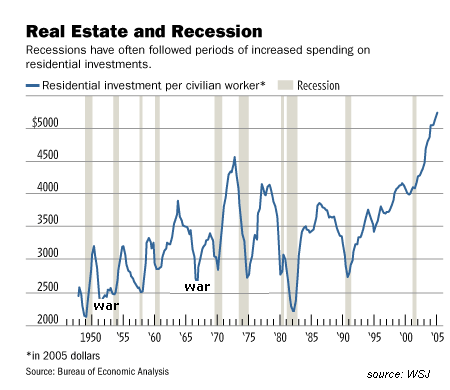
In response to last Wednesday's entry Housing Dominoes Fall, Correspondent Mark D. had this suggestion for a topic: How about an article on the variety of people who thrived after each domino fell?OK, I'll give it a shot. Let's start with this chart, which shows that over-investment in real estate (let's call it a massive mis-allocation of capital) is followed by recession. Is this causal or just bad luck? It's causal; over-investment in any sector produces diminishing returns as supply builds and demand is slaked. At some point, money dumped into the "hot" sector no longer returns a profit or positive cash flow; at that point it is mis-allocated because it would have earned a better return left in a savings account. This chart suggests the recession which will begin in the 4th quarter of 2006 or early 2007 will be a humdinger. Look at the last peak in 1972-73. Those of you alive during the ensuing recession recall that it was the most severe economic downturn since the Great Depression. The next spike of over-investment was followed by another devastating recession in the early 1980s. You can blame Iran or inflation or a host of other factors, but this chart strongly suggests that mis-allocation of capital in residential real estate sets up a very vulnerable economy. 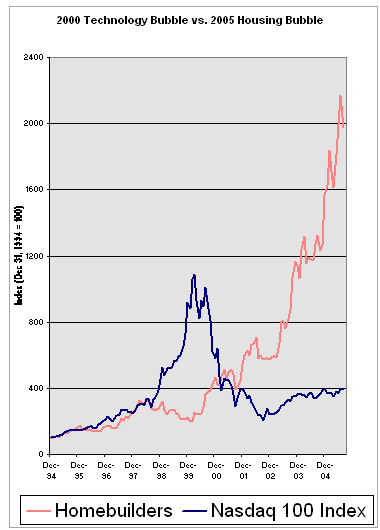 The next chart suggests that the extremes of the housing bubble exceed those of the
dot-com era NASDAQ bubble, which in turn suggests that the severity of the coming decline might
also exceed that of the dot-bomb era wealth destruction.
The next chart suggests that the extremes of the housing bubble exceed those of the
dot-com era NASDAQ bubble, which in turn suggests that the severity of the coming decline might
also exceed that of the dot-bomb era wealth destruction.
Before we look at who thrived after similar dominoes fell in the past, read this disclaimer: There is no investment advice, or advice on anything in any way, shape or form, on this site. There is no advice, implied or otherwise, on this site. If you seek investment advice, please seek it elsewhere. There is none here. Thank you. In a related email on the domino effect, knowledgeable reader M.N. sent me a very thorough 20-point listing of factors in the coming hard landing for real estate. He also had these comments on profiting from the dominoes falling: I believe the investment potential here could be excellent. Between January and March this year I bought puts on some builders exposed to bubble zones which are up about 80%....but the real leverage may be in the 09 puts on some financial institutions.M.N. has already identified two types of people who profited after housing/recession dominoes fell: 1. People who bet against homebuilders and housing-related stocks (i.e. sold shares short or bought put options before the stocks declined) 2. Since housing's decline will hit lenders with foreclosure losses, those who bet against lenders profited from the housing domino's fall. Over at Rick's Picks, Rick foresees a day when Citicorp again trades for $5/share (currently it is $48/share). 3. After the U.S. consumer spending domino falls, those who bet against companies in the discretionary consumer spending sectors (restaurants, travel and leisure, etc.) thrived, as that sector dropped more than non-discretionary consumer spending (healthcare, etc.). 4. Since U.S. consumer spending is 20% of the global economy, those who bet against Non-U.S. companies which were dependent on sales to the U.S. consumer thrived. Since globalization, "peak oil" and massive U.S. currency account deficits are recent phenomena in the global economy, no one knows how a U.S. recession will affect commodities like oil or currencies like the dollar. As a result, we can only speculate using "if/then" statements: 5. If global oil demand remains high despite U.S. recession, then those holding oil and natural gas stocks may thrive. If global demand drops as a result of global recession, those betting on oil's decline will thrive. 6. If the dollar drops below 80, then other currencies and gold will likely rise and dollar-denominated bonds will fall in value. If the dollar strengthens, gold priced in dollars faces a headwind, and other currencies will fall against the dollar. 7. If inflation rises, interest rates will rise in unison, driving down the value of U.S. bonds. If deflation sets in, interest rates will likely decline, and the value of bonds will rise. 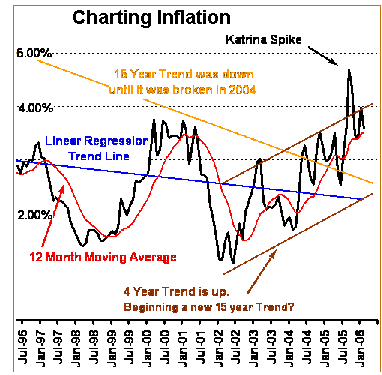 Over at
Mish's Global Economic Trend Analysis (recommended), esteemed blogger Mish makes
some very strong arguments for a long period of deflation somewhat akin to
Japan's 15-year decline from 1989 - 2003. If this scenario plays out, Mish suggests the
smart move would be to buy U.S. Treasury bonds now, as they will rise in value as interest
rates decline.
Over at
Mish's Global Economic Trend Analysis (recommended), esteemed blogger Mish makes
some very strong arguments for a long period of deflation somewhat akin to
Japan's 15-year decline from 1989 - 2003. If this scenario plays out, Mish suggests the
smart move would be to buy U.S. Treasury bonds now, as they will rise in value as interest
rates decline.
While Mish's arguments are compelling, it is also worth noting that interest rates and bonds tend to rise and fall in cycles of about 15 - 22 years. Since interest and bond rates hit bottom in 2003, some analysts (for instance, Louise Yamada Technical Research Advisors) suggest that rates and bonds are in the beginning stages of just such a 15-22 year up-trend. If this scenario plays out, then bonds will decrease in value as interest rates rise. No one knows which broad scenario will play out. There are good arguments for each line of thinking. The deflation scenario rests on the Japanese example, in which interest rates dropped to near zero but no one borrowed or spent much money, so demand dropped which caused prices to drop. The inflation/rising rates scenario rests on the assumption that developing-world growth in China, India and elsewhere will keep commodity prices for oil and foodstuffs high, driving global inflation even in stagnant economies. Other costs such as healthcare continue to rise in good times and bad, further adding to inflation. Regardless of which scenario is correct, here's an observation made by many veteran technical analysts, including Louise Yamada. At the true market bottom, the Dow Jones Industrials stock average (DJ-30) is roughly equal to an ounce of gold. In other words, at the market bottom in 1982, the Dow Jones was about 800, and gold hit $800 an ounce. No one knows if history will repeat, or echo, or simply gag and cough, but it's something to ponder. July 29, 2006 Where There Is Ruin, There Is Profit 
In response to Wednesday's entry Housing Dominoes Fall, Correspondent Mark D. had this suggestion for a topic: How about an article on the variety of people who thrived after each domino fell?This is an excellent subject, for as much money can be made on any decline as on any rise. But before we get to how you can make millions anticipating ruin, I want to share some excellent feedback received in response to the illusion that median home prices are still rising. Several readers gently chided me for my rant of yesterday. While I admit it was a rant (but it was fun to read, wasn't it?) I must point out that the substance of the rant have been well-documented/supported here in dozens of entries. (I must also point out that I received an equal number of emails praisng the entry as being dead-on.) For your further reading pleasure, consider this small selection: Global Warming: The Immensity of Global Warming Sun Sets on Skeptics of Global Warming Healthcare: Obesity and Debt Healthcare: Unaffordable Everywhere A Drug Industry Running Amok Demographics: Demographics & National Bankruptcy Energy Crisis/Lifestyle: American Dream or American Nightmare? The End of Cheap Oil Coming Financial Ruin: Financial Chickens Coming Home to Roost The Housing-Recession-Oil-Healthcare Connection Are We Entering the Next Age of Turmoil? Housing Bubble: Real Estate Bust: The Exhaustion of Debt What Happens When Housing Employment Plummets? The Coming Foreclosure Nightmare 1 After the Bubble: How Low Will We Go, Part II Housing: 10% Decline May Trigger Financial Ruin (click here to view all archived entries, May 2005 - June 2006) The key point of my rant is that we as a nation and species face unprecedented challenges, yet we as a society are content to wallow in a muddled denial, chasing will-o-the-wisp "issues" for political points or seeking to prop up the phony prosperity which is unraveling regardless of what the Fed does or does not do. At the risk of boring you, I reprint the quote from Newt Gingrich which summarizes our profound precariousness: "I believe that the scale of total challenge we face is more like April 1861 than any other period since then," Gingrich says. He goes on to explain that April 1861 was the month Fort Sumter was fired upon, setting off a chain of events--from the Civil War to the construction of the transcontinental railroad to the printing of paper currency--that no one at the time foresaw. "You go back through the cold war, the Second World War, the Great Depression, the First World War--each of those were large, singular, focusable events. In some cases, they were excruciating, but they were containable," he says. "We're going to be hit over the next 15 or 20 years with so many different things simultaneously that the total number of solutions we have to come up with is going to stretch our capacity as a society to talk to itself well enough to actually reach agreement to get something done."If you'd like a list of unprecedented risks, you can start with this one: 1. Climate change (i.e. the new euphemism for global warming). CO-2 up from 220 to 380 in one human lifespan cannot be explained away or ignored. It is affecting the planet's weather. The cause: burning of fossil fuels on a vast scale. 2. Demographics. Every nation, developed and developing, faces a demographic timebomb of fewer workers and unprecedented numbers of retirees. 3. Pensions and Medicare. In our nation, that translates into Social Security and Medicare costs which will soon bankrupt the Treasury. 4. A global financial system constructed on trillions of dollars of derivatives and mathematical models of risk and trading which have never withstood a crisis of the sort which strike all systems from time to time. 5. Wellness and health. Some 60% of the U.S. population is obese to the point that their wellness and health are adversely affected. 45 million Americans have no health insurance. $2 trillion is spent on healthcare but much of it is wasted on bureaucratic paper-shuffling and the last few months of life, as this is profitable and promoting wellness is not. 6. Global housing bubble. Previous financial meltdowns were largely isolated to the stock market, which is concentrated in the hands of a relative few. As the housing bubble pops, it will affect a significant percentage of the nation's citizenry, dwarfing the shadow cast by the dot-com meltdown. This will play out in all nations with property bubbles (China, most of the E.U., etc.). 7. Peak oil. While there may be "plenty of oil left" it is increasingly expensive to tap it. What is undeniable is that cheap oil is in permanent decline. 8. Iran and the Revolutionary Nuke. Iran is poised to acquire nuclear weapons and does not appear to feel much restraint on pursuing its professed agenda of destroying Israel and the U.S. in order to take leadership of global Islam. These are, when taken together, utterly unprecedented in world history. Nuff said. In response to Thursday's entry on how median home prices are still rising in the Bay Area despite a 24% decline in sales, astute reader J.S.D. sent a link to an insightful piece by Jas Jain over at the Financial Sense University SANTA CLARA CO. HOME PRICES: LAGGING VERSUS LEADING DATA. Jain's thesis is that June sales reflect closings which originated in May. Actual sales in July are falling off a cliff, but the data won't show up for a few months: Most of the sales that were pending in early June took place in May and closed escrow in June. Right? No wonder that the median price for escrows that closed in June was nearly identical to the Listing Price of Sales Pending in early June. But, look what has happened to the median Listing Price of Sales Pending in the second half of July, to date? They are down $62-70K, about 8%, from the peak, in just 1˝ months. These Sales Pending will close escrow in August and would be reported in late September. There is 2.5 months of lag in the data that I monitor and the reports.On the same topic, correspondent S.B. shared the expertise of one of his contacts, retired global business exec-turned San Diego-area realtor Bob Casagrand. S.B. had these comments on why median prices could appear to be rising even as sales slump: Whenever I have a (real estate) question I cannot get answered, I turn to Bob.Here is an excerpt from Mr. Casagrand's excellent website: One of the major issues for our market is what does the future demand look like, and only time will tell. I did a rough check on July to date (July 9) to see where it stands, I debated about putting this in this writing because the numbers are scary and they will close somewhat by the end of the month. I decided to put it in so that we can see the mountain ahead to maintain some level of reasonable demand. The first 9 days of July have 303 homes sold for an average price of $559,577 and an average size of 1781 sq ft; the first 9 days of July 2005 had sales of 933 and an average price of $629,168 and an average size of 1749 sq ft. Last July's 933 sales represented 25% of the month's sales, if that were to hold this year, well suffice it to say that would be a disaster. I think this July will stay in the 30% to 35% down from last year region and that would put July sales at about 2,700 homes sold, keeping us a path to about 30,000 home sold for the year, down about 30% from last year.Thank you, S.B. and Bob Casagrand, for illuminating the reasons why median prices could still appear to be rising even as sales fall dramatically. Regarding Wednesday's entry on the domino effect, knowledgeable reader M.N. sent me a very thorough 20-point listing of factors in the coming hard landing for real estate. He also had these comments on profiting from the dominoes falling: I believe the investment potential here could be excellent. Between January and March this year I bought puts on some builders exposed to bubble zones which are up about 80%....but the real leverage may be in the 09 puts on some financial institutions.Thank you, M.N., for sharing these investment ideas. We'll look at more such ideas on Monday. July 28, 2006 Where There Is Ruin IV: Spiritual Renewal And... Friday Quiz: Where Is This? 
I introduce today's Friday Quiz: Where Is This? with a disquisition on the theme of the week, Where there is ruin, there is hope for treasures, a line from the Sufi poet Rumi. Correspondent Mark D. was kind enough to send this photograph and permission to use it as I saw fit. Here is his description of the modest structure: Attached is a picture of a covered covered wagon with a functioning cistern. It should be on the national registry in my opinion. 10 kids were raised in it according to my aunt, and a bachelor lived in it till the 50's.Thank you, Mark, for this wonderful photo of a bygone America. Readers, guess the state where this handbuilt home--a covered "covered wagon," we are told--is located, and I'll send you a collector's copy of my little road/American identity novel I-State Lines. (Guessing is not only allowed, but encouraged.) Note: The following commentary is mine alone, and is not related to either the history of this strikingly humble abode or the views of Mark D. Where there is ruin, there is hope for treasures. The ruin is just ahead, and the treasure is spiritual renewal, not financial wealth. It is precisely the false prosperity of the last six years which will vanish in a great conflagration of debt renounced and wealth destroyed, followed by a new-found appreciation for the values implicit in this small hand-made house on the open prairie. You may detect some righteous anger in these lines; I confess I am the offspring of missionaries. My father's parents were lay missionaries in El Salvador in the years 1919-1925. My aunts and uncle were born there, and my aunts spoke fluent Spanish. Only my father was born in the States. The missionary zeal found expression elsewhere in the clan as well; an uncle of my father served on a mission in Africa, and died there of a tropical disease. The religious tradition of the Scots/English I was raised in valued thrift and modesty, and scorned ostentation in either religious piety or material wealth. Are these values unique to any one faith or creed? Of course not; the Japanese have a word, motainai, which expresses the value of thrift; it's wrong to waste. Japan, too, was once a very poor country where waste was frowned upon. There is a biblical story which seems appropriate to the coming ruin and the destruction of false wealth built on easy credit: Joseph's forecast of seven fat years and seven lean years to the Pharaoh of Egypt. The fat years were those of true productivity (the construction of the Internet, faster cheaper computers, etc.), 1993-1999. By all rights, the speculative excesses of those heady times should have resulted in a downturn of the business cycle and a return to savings for the next seven years, 2000-2006. As we know, The Powers That Be quailed at the prospect of thrift, as it required a recession/downturn in spending. By raising liquidity and lowering lending standards and interest rates, they created another seven fat years--but at a cost. the cost, of course, is a series of imbalances which will topple under their own weight, imbalances which are fundamentally those of excess borrowing and mis-allocation of capital: enormous deficits, real estate speculation run amok (what else can we call a time when 40% of home sales are speculative second or third or fourth properties?) and a negative savings rate. This forced fatness engendered not just financial ruin but a deep, pervasive spiritual rot at the very core of American life. The spiritual hollowness is visible everywhere, and it is not the phony rot hyped by religious zealots of every stripe, but a rot without such easy measure. It is the rot of thrift mocked and borrowing glorified, of real work mocked and speculation glorified, of honesty mocked and business legerdemain glorified, of surplus wasted in an orgy of "entitlements" giveaways, of the following generations heaped with debt while this greedy spendthrift generation piles on benefits and tax cuts for itself. It is the spiritual rot of The Powers That Be mocking those warning of global warming, even as CO-2 levels have risen from 200 to 380 and super-storms displace millions; of corporate "leaders" raking off millions, marrying their young secretary and then lecturing the avaricious hordes beneath them on how "to make it" in a global economy; of Yahoo Finance glorifying "the most expensive houses" and "private islands" weekend after sickening weekend, the analog of the glorification of talentless "celebrity" and crass gangster "bling" as the height of American culture. The default setting of American poltical culture is similarly rotten to the core, of sleazy fat politicos riding around in a hybrid car for a block to reveal their support of "green technology" and then slipping into their oversized SUV once safely out of camera range. If money has long been the other's milk of politics, it is now the coffee, chips, steak and dessert as well. The default setting of American "middle class" life is a family-destroying commute to a cul-de-sac McMansion in which the kids are upstairs in an air-conditioned "paradise" with the door locked, communing with the outside world via IM and earphones, their rooms cluttered with the cheap outpouring of Chinese manufacture, their friends bought off with money supplied by parents who are too busy to be involved and too self-absorbed with their own status and wealth to care. That symbol of excess, the SUV or big pick-up never sullied by actual work, sits in the driveway, boasting that the owners care about safety above gas mileage, and as long as they can make the monthly nut on all that mountain of debt they took on to buy the McMansion, the big vehicles and the rest of the half-broken junk filling their garage, then the American Dream is alive and well. Never a borrower or a lender be--get real! Lowest rates in a generation! What can one say about a society which spends more on medical care than any other, and yet 45 million citizens have no medical insurance and 40% are overweight to point that their health--their greatest wealth--is compromised? That this "free enterprise system of consumer choice provides the best care in the world"? Is that what you call shamefully high infant mortality rates, and a population which is measurably less healthy than our developed-world brethren? Is a system which enables doctors and lawyers to make millions and pharmaceutical companies to reap billions really set up to "provide the best care in the world" or simply the most profitable care in the world? We're told that the two are in fact one: profit drives the best care. Really? Then why as a society are we so sick, and why do we pay so much to be so unhealthy? Yes, I admit it. I look forward to the collapse of this false prosperity, the ruination of all speculation, of government deficits, of ostentation without meaning or limit; for only in this complete ruin is spiritual renewal possible. If you would like to see a parable of just this, please rent Spirited Away: Decay and Renewal. July 27, 2006 Why Is the Median House Price Still Rising?
(source: DataQuick Information Systems' July 19 press release, Bay Area home sales continue to drop, prices reach new peak) OK, Mr. Housing Bubble Bursting, how come San Francisco Bay Area housing prices keep rising? Doesn't that puncture your "the housing bubble is popping" thesis? Good question. According to Dataquick (click on link above for their full report), sales in the nine Bay Area counties (which have a population of about 7.5 million) dropped 24% even as prices rose 5.6%. (Emphasis in bold is mine.) A total of 9,892 new and resale houses and condos were sold in the nine-county region last month. That was up 9.1 percent from 9,064 for May, and down 24.0 percent from 13,014 for June last year, according to DataQuick Information Systems.Is this some sort of statistical legerdemain, or does it simply mean people are continuing to pay higher prices for housing? There may be some statistical skewing here, but I don't have the data to make that analysis. For instance, the lower-priced homes may actually be dropping in price, but a relatively small number of very expensive homes could mask that drop since all the sales numbers are combined. BUt let's just grasp the nettle and wonder how sales could drop by 24%--clear evidence that demand is slowing--yet prices continue to rise, albeit at a slower pace? This phenomenon is not unknown in other markets; in the stock market, one sign of a market which is topping out is a narrowing of market breadth even as the indices continue to rise. What does that mean? Simply that fewer stocks are rising, but their market value is big enough that their advance lifts the entire index. So even if 90% of the stocks are flat or falling, the top 10% big-capitalization stocks can continue to drag the entire index higher. The analog would be a few $2 million homes masking a decline in the $450,000 segment. But this data is clear: about 10,000 people paid the going price in June for a home in the Bay Area. So now we come to a Butch Cassidy-Sundance Kid moment: "Who are these guys?" Indeed. Who is still buying aging bungalows for over $600,000, even as the mortgage costs $440 more than a year ago (not to mention higher property taxes)? Affordability statistics tell us that only 10% of Bay Area residents can afford a median priced home, so--who's still buying? Don't the majority of these high-value, high-wage folks already own a home? As reported in the U.S. News & World Report: In Los Angeles, the cost of home owning has doubled over the past five years, rising from 31 percent to 55 percent of median income. That means only 2 percent of the homes sold there are affordable by families earning the area's median income of about $47,000 a year. To qualify for conventional financing of a median-price home of $500,000, with a 20 percent down payment, buyers would need an annual income of about $120,000. In New York, only 6 percent of those who earn a median income can afford to buy a median-price home. In San Francisco, the number is 7 percent.I have two theories. #1.: Many of these buyers sold late last year near the top, and since they cashed in their winnings, the absurd valuations seem "normal" to them. In other words, if you sold your house for $750,000, then $800,000 doesn't sound too outrageous. Not everyone buys a replacement house immediately; and since sales have been dropping for months, the pool of people who sold out in 2005 is larger than the pool of current buyers. A certain number of people who cashed out moved from the area, of course, and so they have left the pool of potential buyers. So who's still willing to step up and buy a house now, despite the constant talk of the housing bubble popping? My theory #2: the majority of people do not really believe housing can drop appreciably. It hasn't happened in their lifetime;the modest decline in the early 90s didn't affect them at all. So their experience is: housing prices plateau but never really drop. And indeed, this has been the case for decade after decade in the Bay Area. One of our close friends just bought a house for about $800,000. Like me, he saw the rapid rise in house values as a bubble; but unlike me, he has an infant, and he and his wife aren't willing to live in a flat for the next 4-5 years while the market drops. So he got a fixed-rate mortgage and bought the fixer-upper. (Yes, a fixer-upper in a desirable neighborhood still commands close to a million bucks.) I don't think he's alone. If people can make the monthly nut, they just ignore the price tag and buy the place, reckoning any drop will mirror the early 90s--that is, a temporary decline of maybe 5% - 10%. But since they have a fixed-rate mortgage, who cares? The key to this kind of confidence, of course, is a parallel belief that the U.S. economy will continue chugging along at near full-employment. Nobody worries about making that monthly nut--until one of the wage-earners loses their job. For most people, after two decades of largely uninterrupted growth and prosperity, to worry about a severe recession which could actually impact their income and lifestyle is akin to worrying about a meteor strike: theoretically possible, but so unlikely it isn't worth worrying about. At this point I am reminded of the line from the Jackon Browne song, Road and the Sky: "Don't think it won't happen just because it hasn't happened yet." If foreclosures rise as I have posited (see yesterday's links), and if employment drops significantly in housing-related sectors, then those will be enough to tip the U.S. economy (and thus the world) into recession--never mind rising interest rates and $100 a barrel oil. Once people start getting laid off in non-housing sectors of the economy, then the see-saw will really start its downward move. And then the value of one's house will start to matter because an increasing number of families won't be able to make the monthly nut that once seemed so affordable. And being unable to make the nut, they'll need to sell--and real quick-like. Only there will be thousands of other people in the same predicament--yes, gasp, even here in the endlessly prosperous Bay Area, home of the Limitless Family Trust Fund and backdated stock options. Maybe I'm all wrong about this; we won't know for another year. In the meantime, here's another story on the topic: Home prices inch up; rents rise, sales ebb High costs -- and interest rates -- cause more people to hit 'the affordability wall.' July 26, 2006 Where There Is Ruin III: Housing Dominoes Fall 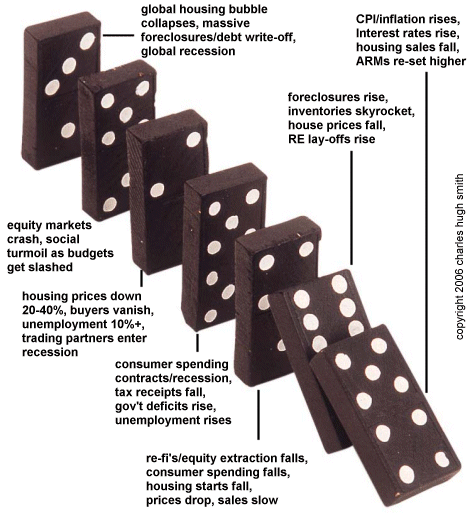
As housing rolls over, the dominoes are beginning to fall. The last domino? Global recession. Surprise of surprises, the business cycle cannot be revoked. (Didn't we learn that in the dot-com era? I guess not.) Rising investor demand (greed) causes prices to rise, stimulating more supply to capitalize on that demand (more greed) which leads to massive oversupply and a calamitous collapse in price. This works for wheat, routers, houses, you name it (and from time to time, even in oil/energy). So it's no surprise that as housing inventory builds and the costs of ownership rise, prices fall. What may surprise some is the domino effect: as housing tumbles, so does the U.S. economy--and with it, the global economy. But let's not rush to the denouement. Let's go down the line of dominoes. Domino 1. As noted here before, the 24-year decline in interest rates is over, and a new long cycle of rising rates is now apparent. The handlers of the CPI (consumer price index) are being hoist on their own petard as rents, which fell during the housing bubble's inflation, are now rising as the bubble deflates. As 40% of the CPI, rents will, along with the high energy costs now entering the supply chain, cause a continuing rise in consumer costs. Interest rates will rise accordingly. (See Why Post-Bubble Rents Matter and The Housing - Inflation Connection) Domino 2. As ARMs reset (adjustable rate mortgages), more recent buyers are forced into foreclosure or liquidation, placing even more inventory on the market. Inventories are already at multi-year highs, and the real flood of distressed properties hasn't even started. The enormous quantity of new housing in the pipeline--either under construction or permitted--will only add to this rapidly increasing inventory. Investors--some 40% of recent buyers--can also be expected to add to the properties on the market. As inventory climbs, prices fall. It's classic supply and demand. (See The Coming Foreclosure Nightmare 1 and How Many Foreclosures Will Hit the Market? and Housing Wealth Effect Shifts Into Reverse ) Domino 3. As housing appreciation grinds to a halt and starts declining, the stupendous equity extraction which supported consumer spending for the past 5 years dries up, causing consumer spending to fall (once credit card limits are reached). A negative feedback loop is in force, with falling prices triggering more listings and more buyer hesitation. As sales, lending and building decline, employment in these sectors also falls, further slowing consumer sales as incomes drop. (See What Happens When Housing Employment Plummets?) Domino 4. As Unemployment rises and housing sales and consumer spending fall, government tax revenues decline. Deficits rise, and governmental services are trimmed, causing widespread political conflict over the shrinking pie of governmental resources. (See Housing Bubble: Where's the Bottom? and Housing Bubble: Bottom II) Domino 5. The momentum of the negative feedback loop gathers force. Sales plummet, prices drop precipitously as sellers become desperate and auctions abound, and faltering consumer sales cause corporate profits to decline. Lay-offs in non-housing sectors increase, exacerbating the rising unemployment in housing-dependent sectors (some 15% of the U.S. economy). (See After the Bubble: How Low Will It Go? and After the Bubble: How Low Will We Go, Part II) Domino 6. As consumer spending in the U.S. falls, imports from our export-dependent trading partners (China, Japan, the E.U., etc.) fall, triggering the same recessionary negative-feedback loop of rising unemployment, falling lending, falling real estate valuations, falling corporate profits and falling government revenues. Global equity markets decline and then crash as future profits are recognized as in decline. (See Real Estate Bust: The Exhaustion of Debt) Domino 7. Regardless of the price of oil or the value of the dollar, the global economy sinks into a deep recession. The deflation of real estate assets and the liquidation of bubble-era debt feed on each other, spiraling down along with employment and lending. (See China's Dependence on Exports to U.S. and Will the Housing Bust Take Down China?) Say it isn't so, Joe. Tell us housing never declines (not true), that debt can rise forever with no consequences (not true), that declining housing sales and lending won't trigger a rise in unemployment, that consumer spending will stay strong even as equity extraction dries up and the savings rate is negative, and indeed, that there is no bubble in housing values, as they have reached a new plateau which will never be breached, even though only 9% of the citizenry can afford the median price of homes. Sorry, but the dominoes are already falling, and the momentum is in the downward direction. Each weakness feeds on the others, and there is no force in the Universe which can re-inflate the rise in property values and lower interest rates back to 30-year lows. The conditions have changed, and the ruin is only starting. (See Housing: 10% Decline May Trigger Financial Ruin and Housing Bubble Bust Will Take Down the Global Economy) July 25, 2006 Where There Is Ruin II: Social Security 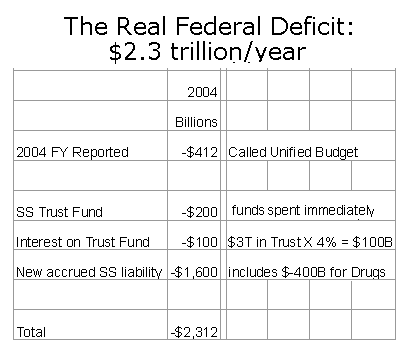 Correspondant Michael Goodfellow has graciously allowed me to reprint his analysis
of the looming Social Security funding crisis.
Correspondant Michael Goodfellow has graciously allowed me to reprint his analysis
of the looming Social Security funding crisis.
The net result: the crisis isn't decades away--it's only a few years away. Read on to see why. (emphasis added in bold is mine.) Michael tells me the statistics were assembled a year ago, but I don't think newer data would affect his analysis; the forces being measured are the demographics of the baby boom, which were set in the period 1946-1964. The only variable is when Boomers retire--at 62 or 66--and that will not materially change the dire financial circumstances we face. The accompanying charts are not Michael's, but they provide graphic representations of the problem he so ably describes. Here is his analysis: It's hard to make heads or tails of the current debate over Social Security. Sometimes it seems like you just have to find an editorial you like the sound of and trust it. After all, how could you know anything personally about the future of Social Security? But it turns out, you can do a bit of research on your own. The figures involved are not a secret!Thank you, Michael, for a cogent and devastating analysis of a ruinous crisis for which we as a nation have no solution. To repeat Newt Gingrich's comment from yesterday's entry: "We're going to be hit over the next 15 or 20 years with so many different things simultaneously that the total number of solutions we have to come up with is going to stretch our capacity as a society to talk to itself well enough to actually reach agreement to get something done." July 24, 2006 Where There Is Ruin 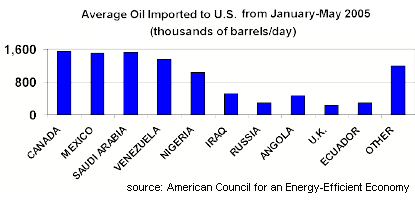 One of my favorite lines from the poet Rumi is "Where there is ruin, there is hope of
treasures." Unfortunately, I fear we have not yet reached the state of ruin--though we may
be close.
One of my favorite lines from the poet Rumi is "Where there is ruin, there is hope of
treasures." Unfortunately, I fear we have not yet reached the state of ruin--though we may
be close.
Someone who seems to share the same perspective is Newt Gingrich, former Speaker of the House of Representatives. Politicos tend to have a love/hate view of Newt, understandably so given his rabid partisanship and phenomenal ability to hoist himself on his own petard. (Recall that Newt gave "compassionate conservatism" a newly ironic twist by serving his second wife divorce papers while she lay in a hospital bed.) But regardless of your previous opinions of Mr. Gingrich, read the following excerpt from The New Republic's Recent Profile of Newt Gingrich and see if if it doesn't strike you as insightful: "I believe that the scale of total challenge we face is more like April 1861 than any other period since then," Gingrich says. He goes on to explain that April 1861 was the month Fort Sumter was fired upon, setting off a chain of events--from the Civil War to the construction of the transcontinental railroad to the printing of paper currency--that no one at the time foresaw. "You go back through the cold war, the Second World War, the Great Depression, the First World War--each of those were large, singular, focusable events. In some cases, they were excruciating, but they were containable," he says. "We're going to be hit over the next 15 or 20 years with so many different things simultaneously that the total number of solutions we have to come up with is going to stretch our capacity as a society to talk to itself well enough to actually reach agreement to get something done."I think Newt's key insight is that we are poised on the edge of crises for which there are no predictable projections or outcomes. Consider this excerpt from another TNR piece on the Lessons of the 1967 War in the Mideast: Now, as the region teeters on the brink of a new and potentially more violent cataclysm, it is important to revisit the lessons of the Six Day War, a conflict that few Middle Eastern countries wanted and none foresaw.Is the present conflict between Hezbollah and Israel a similarly unstable situation fraught with the risk of spinning out of control? While that scenario is by no means inevitable, given the region's history, it does retain a certain plausibility. Armchair strategists willing to take an objective, even disinterested point of view of the conflict might well conclude that Hezbollah is in a win-win situation and Israel is in a lose-lose situation. If Israel continues the campaign to degrade Hezbollah's military, then Hezbollah can portray itself as the heroic resistance and Israel as the killer of civilians. If Israel stops the campaign, then Hezbollah declares victory. 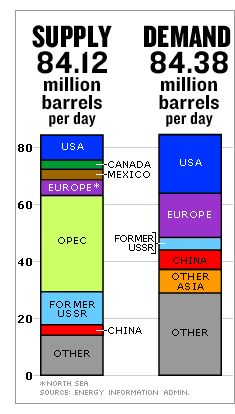 Looking beyond southern Lebanon, armchair strategists may ponder what, from the Israeli
perspective, can be done to disrupt the flow of cash, supplies and weaponry from
Syria and Iran to their sworn enemies, Hezbollah. One choice is an all-out war against these
two nations, but the outcome would be unpredictable and Israeli losses might be heavy.
An alternative would be to simply disrupt or destroy the source of both Syria and
Iran's revenue: oil.
Looking beyond southern Lebanon, armchair strategists may ponder what, from the Israeli
perspective, can be done to disrupt the flow of cash, supplies and weaponry from
Syria and Iran to their sworn enemies, Hezbollah. One choice is an all-out war against these
two nations, but the outcome would be unpredictable and Israeli losses might be heavy.
An alternative would be to simply disrupt or destroy the source of both Syria and
Iran's revenue: oil.
Destroying the fragile network of pipelines, refineries, storage tanks and dock facilities which generate approximately 90% of the revenues of both Syria and Iran would offer several advantages: the effect would be immediate, the cost in aircraft low, and the risk of civilian casualties much lower than in a ground assault in Lebanon. Oil facilities are not hardened targets--on the contrary, they're explosions and fires just waiting to be set off. Who might protest such destruction, other than Syria and Iran? The West, of course, as the price of oil would quickly rise to unpredictable heights. But as the chart above reveals, not all of the West relies on Iranian and Syrian oil. The U.S., it seems, does not import oil from these nations. The clear winners in such a scenario would be those oil exporters whose capacity remained undamaged, which in the Mideast would be the Sunni nations who may well have some concerns about Shi'ite Iran's regional aspirations. There would be some irony in this scenario, as Iran has constantly held out the disruption of oil as their leverage over the West. What if their ability to supply oil was wrested from their grasp by a co-ordinated air attack? Their leverage would rapidly sink to near zero. Just how much oil would be lost to global supply if Iran and Syria's oil infrastructure was destroyed in a series of air strikes? According to Iran may threaten oil weapon, Arabs will not, perhaps 3% of current supply: Iran, OPEC's second biggest producer, supplies the world with more than 2.4 million barrels per day (bpd), making it the fourth biggest exporter. Traders say a loss of this amount would be hard to replace as, except for about 2 million bpd of spare crude oil capacity in top exporter Saudi Arabia, OPEC is pumping flat out. Syria exports only about 200,000 bpd of oil.Armchair strategists might expect Russia to protest, but not too much, as the skyrocketing price of oil would quickly boost its own revenues. The developed and developing nations would both suffer severe dislocations if the cost of oil rose above $100, but conservation and rapid investment in alternative sources of energy would eventually fill the gap created by the disruption of Iranian and Syrian oil exports. Once deprived of 90% of their revenues, Iran and Syria's export of aid to groups such as Hezbollah--not to mention the maintenance of the social welfare systems on which their leaderships depend for political support--would become increasingly difficult to fund. Would Iran and Syria strike back as Israel, starting a wider, lengthier open-ended war? Perhaps, but their ability to rebuild their revenue source would only suffer more damage in a wider, longer war. Given Israeli air superiority, would such a war offer any benefits to Iran and Syria? This is, of course, mere speculation on what armchair strategists might ponder. Who else might be speculating on such scenarios? Planners in various governments, perhaps? We have a winner! In a bit of detective work worthy of Sherlock Holmes, Charles H. correctly identified the Friday Quiz mystery ("pirate's treasure") beach: "First guess is Hawaii based upon your living there 1/2 your life. Since you live on Oahu, I'm looking at the water and notice the quick depth. That rules out most of Waikiki and the Windward side since they tend to have the shallow reefs up to shore. So could be West or North shores. The angle of the sand is relatively flat but drops off moderately to the shoreline. Not a sheer drop but not gradual either. Not a lot of people but a nice sunny day means a little less populated part of the island. The water looks deep green in color but not deep blue. The west goes deep blue quickly due to the depth. Not a close to shore surf area. That makes me think more of the Mokuleia part of Oahu. That's my guess and reasoning. Mokuleia, Oahu." Congratulations, Charles! A free collector's copy of I-State Lines is heading your way. What a great conclusion to Pirates Week! July 22, 2006 A Real Pirate Movie  "Fluently." Errol Flynn's witty reply comes from Robin Hood, but it also captures the soul of his pirate classic, Captain Blood. The charge of treason was unreasoning and injust in the extreme; Blood was merely a doctor treating the wounded of the English civil war. Sentenced without regard to his innocence, he is sent to a hellhole prison island in the Caribbean and must join a daring escape with other nothing-to-lose prisoners. After the escape, he turns to piracy--ironically, a "brotherhood" of rough-hewn democracy and loyalty at the very opposite end of the spectrum from the society which cruelly imprisoned him over an imagined political crime. As a pirate Captain, Blood is fair and just--again, in stark contrast with the government which so cavalierly convicted and enslaved him. The female interest, Olivia de Havilland, at first heaps scorn on him as a low-life traitor who obviously deserved his fate; this being Hollywood, she eventually sees the error of her assumptions and falls for the dashing pirate. While all of this sounds like typical adventure, its timelessness rests partly on its subtext of injustice and suffering being defeated not through an oppressive, corrupt "system" but through comradeship and an anti-hero idealism: though we be pirates, we hold to a code of honor, and plunder only the wealthy. There is a mythic quality to this storyline, of course, but there is also a very clear "anti-hero" thread to Blood's rejection of "official" justice and his embrace of a rough-and-ready justice dealt out with the blade of a sword and a broadside of cannons. This must have resonated especially powerfully with Depression-era audiences. What was the Depression if not a heaping of undeserved poverty on the innocent masses? The "system," controlled by a self-serving financial and political elite, had failed spectacularly; this film depicts a scenario in which the struggles to escape the imprisonment of poverty and passivity are eventually rewarded--but only after the "crew" adheres to a shared set of just rules: the pirates' code of honor and the election of a strong, idealistic, fair-minded captain. The great irony at the heart of this film is that true justice lies not with the system but with the pirates, the supposed renegades. Captain Blood achieves his redemption not by docilely awaiting "justice" from his overlords (their verdict was basically an appeals-free death sentence), but by escaping the prison and fighting the system of wealth and privilege on the high seas. It is interesting to speculate what might have become of Captain Blood in the film world of the 1970s, the heyday of anti-heroes. Perhaps Blood would have rejected clemency and remained a pirate. But in the 1930s, the "system" was viewed as capable of recognizing injustice and correcting it. Was this a political subtext or simply story-telling? If you consider the widespread suffering of people during this time, you might find a message not for 1685 but for the era in which the film was made (1935, at the height of the Great Depression). Regardless of any subtexts, we root for Captain Blood precisely because he was wronged, and we find great satisfaction in his contempt for the harsh and faulty judgment of the ruling class. We cheer when he looses a broadside into his "betters" who so breezily sent him to a death-camp. Great adventure, great story, great message: Blood was forced to overcome injustice by breaking out of the system rather than passively awaiting a justice which would never have come. For Real Pirates, not Disney Posers, Click Here! ads by Groogle July 21, 2006 Friday Quiz, Pirate Week Special: Where Is This?  Here is the secret to my ability to fund this wretchedly unprofitable website. Yes, I
discovered a pirate's treasure chest. I'm slowly auctioning off the pearls, rare
gold coins and assorted jewelry on eBay that were plundered so long ago. Which reminds me of the old
joke. A writer wins a million dollars in a lottery, and a friend asks, "Gee, what are you
gonna do with the money?" The writer replies, "Keep writing til the money runs out."
Here is the secret to my ability to fund this wretchedly unprofitable website. Yes, I
discovered a pirate's treasure chest. I'm slowly auctioning off the pearls, rare
gold coins and assorted jewelry on eBay that were plundered so long ago. Which reminds me of the old
joke. A writer wins a million dollars in a lottery, and a friend asks, "Gee, what are you
gonna do with the money?" The writer replies, "Keep writing til the money runs out."
Cue a pathetic round of bitter laughter. Yes, writing does not generate much treasure unless you're Stephen King, Tom Clancy, Anne Rice, et. al. To survive, some of us free-lance in the only lucrative alley of writing: marketing. So feast your eyes on this ad I wrote for Kroika! cookies, featuring the handy-with-a-rapier star of the Disney "Pirates of the Caribbean" franchise (reviewed here on Monday), Keira Knightley.  The ad, of course, will be translated into various Asian languages and then quickly
distributed into Kroika's Asian markets. Disney's lawyers won't have time to track
down the source until the ad
agency has vacated its temporary quarters in Xiangxi. (They just move down the hall, place
another name on the door, and that's the end of Disney's legal claims. What could be more
appropriate that pirating a pirate movie?)
The ad, of course, will be translated into various Asian languages and then quickly
distributed into Kroika's Asian markets. Disney's lawyers won't have time to track
down the source until the ad
agency has vacated its temporary quarters in Xiangxi. (They just move down the hall, place
another name on the door, and that's the end of Disney's legal claims. What could be more
appropriate that pirating a pirate movie?)
The treasure, alas, is fake, but the location is real. (hint: this is not the Caribbean. There is an obvious clue elsewhere on my website.) Be the first to identify this specific beach, and I'll send you a collector's copy of my book I-State Lines. So email me! Speaking of treasure, the only real "treasure" on this site is literary. What makes literary fiction different from airport lounge/beach reading? That it's boring and unreadable? Sadly, that is often true. But the real difference is there is nothing beneath the surface story in a thriller or romance; the surface is all you get. A literary novel, in contrast, is supposed to offer layers of meaning which reverberate through your reading and long after. It has a surface plot or story, but there are layers beneath which can be explored should the reader be so inclined. The success or failure of expressing these meanings define the success or failure of the novel. (Its financial failure is already a given.) I could illustrate this with the literary novel I'm currently reading, The Confidence-Man by Herman Melville (reportedly the author's favorite of his own work), but then why use a difficult-to-read masterpiece when there's an easier, more fun read close at hand? Like, say, for instance, this little book which happens to be mine (and hopefully yours), I-State Lines. There's room for everybody on board the confidence man's Mississippi river boat (who's conning who is the question), just as there's room for easy-to-read thrillers and hard-to-read masterpieces on everyone's bookshelves. So when Alex and Daz visit San Francisco for the first time, guided by new friend and romantic interest Nikki, the surface is a fun tromp through the tourist-trap bits of the City and some residents-only hideaways. But the chapter is also an exploration of friendship's underside, of suppressed rivalry and jealousy, and of romance's awkward, tentative beginnings. Of course you're curious, aren't you? Here it is: A Day in the City. And here is another helping of literary treasure, a short "letter from Basque Country" by author/artist John Kinsella. (A link to his main website can be found in the righthand sidebar.) John is writing from his summer haunt, the town of Hendaye. Enjoy! You can get I-State Lines from my favorite online independent bookstore, The Kaleidoscope: Our Focus Is You (Shipping is free on all orders). Or if you have an open order at amazon.com, you can of course add I-State Lines Want to see a real pirate movie, Matey? Click here! ads by Groogle July 20, 2006 Hot Air Dragon: Is China About to Pop? 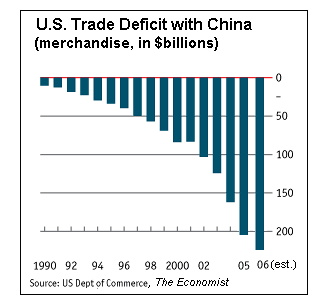 First, let's acknowledge--and dismiss--the main subtexts which play out in any
discussion of U.S.-China trade: Many of the
"China is the inevitable superpower of the 21st Century" crowd are, beneath their
cheerleading, deeply anti-American; they hope China replaces the U.S. as the global
superpower not because they are enamoured of China (though they may be) but because
they loathe the policies and indeed, the power, of the U.S. In this they are akin to the Soviet
sympathizers who romanticized life in the Cold War gulag/USSR because they disapproved of U.S. policy
and power.
First, let's acknowledge--and dismiss--the main subtexts which play out in any
discussion of U.S.-China trade: Many of the
"China is the inevitable superpower of the 21st Century" crowd are, beneath their
cheerleading, deeply anti-American; they hope China replaces the U.S. as the global
superpower not because they are enamoured of China (though they may be) but because
they loathe the policies and indeed, the power, of the U.S. In this they are akin to the Soviet
sympathizers who romanticized life in the Cold War gulag/USSR because they disapproved of U.S. policy
and power.
On the other hand, China bashers view everything through the prism of a "clash of civilizations" in which China is constantly working to weaken U.S. interests in order to replace the U.S. as the global superpower. Every act is viewed not as China's understandable impulse to act in its own self-interest, just as the U.S. does, but as an attack on U.S. interests  I do not ascribe to either of these uninformed, ideologically-driven islands of ignorance.
Yes, China was once a great power (circa 1450 and before), and it may yet become a
global power, but it is not yet a global power and it has many challenges to overcome. Like any
other large nation, it will naturally have some areas of disagreement with the U.S. but
it need not be viewed as an either-or alternative to U.S. power. The Pacific, and indeed, the world,
is big enough for Japan, China, and the U.S. to be large economic and military powers. Yes,
Taiwan provides a dangerous point of friction which could lead to open war, but that scenario
is by no means inevitable.
I do not ascribe to either of these uninformed, ideologically-driven islands of ignorance.
Yes, China was once a great power (circa 1450 and before), and it may yet become a
global power, but it is not yet a global power and it has many challenges to overcome. Like any
other large nation, it will naturally have some areas of disagreement with the U.S. but
it need not be viewed as an either-or alternative to U.S. power. The Pacific, and indeed, the world,
is big enough for Japan, China, and the U.S. to be large economic and military powers. Yes,
Taiwan provides a dangerous point of friction which could lead to open war, but that scenario
is by no means inevitable.
While this either-or choice--"which will be the sole superpower, the U.S. or China?"--appeals to both ideological extremes, it is deeply false. It is far closer to the complex, nuanced truth to say that China and the U.S. have become mutually interwined in a vast commercial and political enterprise. Each now needs the other for its prosperity and to some degree, political/regional stability. The big question now is: what happens to Chinese prosperity as the U.S. housing/debt bubble bursts and the U.S. slides into a deep recession? This question is important to citizens of both nations, but most especially to the Chinese citizenry. As these photos demonstrate, I have made several lengthy visits to China; we have many Chinese friends, and I hope for the security and well-being of all citizens of both the U.S. and China. I do not see the two as mutually exclusive. OK, so let's dig in. First up is China's blistering growth: China reports fastest growth in a decade.  Sounds great, doesn't it? But if we look beneath the surface statistics, there are some
very troubling imbalances. Let's turn to Elaine Kurtenbach's (of the Associated Press) piece
China struggles to tame economy. The presence of a real estate bubble is now
undeniable, as is the astonishing dependence of China on investment for its growth:
Sounds great, doesn't it? But if we look beneath the surface statistics, there are some
very troubling imbalances. Let's turn to Elaine Kurtenbach's (of the Associated Press) piece
China struggles to tame economy. The presence of a real estate bubble is now
undeniable, as is the astonishing dependence of China on investment for its growth:
"Chinese authorities are now scrambling to regain control over a runaway economy," Morgan Stanley economist Stephen Roach wrote in a recent report. "China needs a more serious policy tightening."  Exactly where is the good news in this "growth"? Half the GDP is investment
money from abroad or borrowed from shaky central banks, and much or even most of
that vast ocean of money has been mis-allocated into bubble-market luxury real estate
or industries which are already bulging with over-capacity.
Exactly where is the good news in this "growth"? Half the GDP is investment
money from abroad or borrowed from shaky central banks, and much or even most of
that vast ocean of money has been mis-allocated into bubble-market luxury real estate
or industries which are already bulging with over-capacity.
This is a recipe for fiscal disaster, not sustainable growth. The dominoes are rather obvious: China is massively dependent on trade with the U.S. (for more on this, see the excerpt below); as this trade shrinks with a U.S. recession, Chinese exports--and profits, wages, etc.--will be negatively impacted. China is also dependent on either domestic loans (which have a long and ruinous history of being allocated for graft or political reasons rather than financial reasons) or direct foreign investment, which has a hisotry of rapidly drying up in times of recession or uneasiness. Some cheerleaders claim China no longer needs exports to grow, that it can prosper just from the rise of domestic consumers. This excerpt demolishes that absurd hope. If you want a detailed precis on the complexities of U.S.-China trade, read the entire two-part story: PART 2: The US-China trade imbalance By Henry C K Liu (published in the Asia Times: These figures show that trade is now a precariously excessive portion of Chinese GDP. And without a trade surplus with the US, China would face a global trade deficit of about 6.25% of GDP, more than the United States' 5.7%.As a lagniappe, read these, too: Why the U.S. China Trade Imbalance is Unsustainable. China Snags (An interesting long view, written by an American who has lived in taiwan for several years.) Find Out About Admiral Zheng's Fabulous Fleet! ads by Groogle July 19, 2006 Retail Sales and Rising Debt: Could They Be Connected? 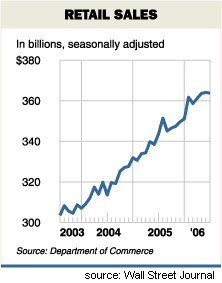 Retail sales, after years of steady growth, has finally faltered. Since wage growth
has been essentially flat since 2001, we have to wonder: where did all that money come from, if
not from wages?
Retail sales, after years of steady growth, has finally faltered. Since wage growth
has been essentially flat since 2001, we have to wonder: where did all that money come from, if
not from wages?
Here's part of the answer: The amount of outstanding credit card debt has more than quadrupled since 1990, to $696.7 billion, according to CardWeb.com. If we look at the growth in retail sales from 2003, and then look at the amount of home equity loans taken out in the same time frame, another source of funds is rather obvious: HELOCs, or home equity lines of credit. In sum: that lovely, profitable rise in retail sales was borrowed money, funds drawn off credit cards or home equity lines of credit or via re-financing of existing mortgages at higher balances. 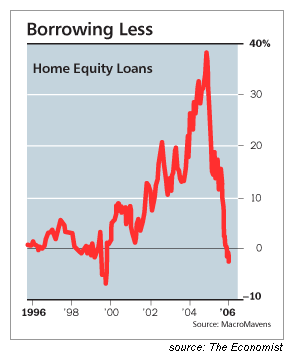 Somewhat less obvious is another source of spending money: the savings gained by re-financing
a higher-interest fixed-rate mortgage to a lower ARM (adjustable-rate mortgage):
Somewhat less obvious is another source of spending money: the savings gained by re-financing
a higher-interest fixed-rate mortgage to a lower ARM (adjustable-rate mortgage):
According to the Office of Federal Housing Enterprise Oversight, the volume of ARMs tripled between 2001 and 2004, from $304 billion to $985 billion in 2004. At the end of 2004, there were about $1.4 trillion in ARMs outstanding. That figure is likely significantly higher today, since the ARMs accounted for about 31 percent of the $2.9 trillion in mortgages issued in 2005, according to the Mortgage Bankers Association. For every 100 basis points (i.e., 1 percent) mortgage rates rise, holders of adjustable of ARMs will owe an extra $14 billion per year in interest.  Here's more evidence that American homeowners have been pulling equity out of their homes
in an orgy of re-financing:
Here's more evidence that American homeowners have been pulling equity out of their homes
in an orgy of re-financing:
Re-Fi's Hit a 15-Year High: A greater proportion of mortgage refinancers tapped their home equity for cash in the first three months of this year than in any other quarter in the past 15 years, according to an analysis released yesterday.  88 per cent is a very hefty majority. Shall we connect the dots? How can anyone
conclude that the current "prosperity" reflected in those wonderfully ever-rising retail
sales is anything but borrowed money being spent (or shall we be honest and
say wasted?) on non-productive services and goods such as vacations, furniture and
Chinese-made gew-gaws?
88 per cent is a very hefty majority. Shall we connect the dots? How can anyone
conclude that the current "prosperity" reflected in those wonderfully ever-rising retail
sales is anything but borrowed money being spent (or shall we be honest and
say wasted?) on non-productive services and goods such as vacations, furniture and
Chinese-made gew-gaws?
Even money poured into home improvements isn't really productive; a new granite countertop doesn't really add much to the value of a home (especially when it's dropping like a stone), nor does it create income. All the "investment" in housing and home improvement made during the bubble is essentially money that has been mis-allocated into non-productive assets (rental housing excepted). Now that the heavy borrowing off home equity is drawing to a close (see above chart), the weight of all that "dead money" dumped into housing is starting to weigh on consumers. The dead money generates no income, but the loans made still have to paid. And as all those interest-only loans click over to loans which require payment of principal, the "pinch" felt by consumers will become a bone-crushing vice. July 18, 2006 A Whiff of Apocalypse 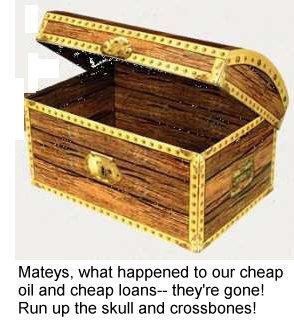 Napoleon famously cleared a mob of protesters in Paris with a "whiff of grapeshot," a
peculiarly innocuous-sounding reference to a murderously effective cannonade of shells
filled with hundreds of musket balls-- a giant shotgun, if you will, whose massed
bullets inspired the breezy reference to clusters of grapes.
Napoleon famously cleared a mob of protesters in Paris with a "whiff of grapeshot," a
peculiarly innocuous-sounding reference to a murderously effective cannonade of shells
filled with hundreds of musket balls-- a giant shotgun, if you will, whose massed
bullets inspired the breezy reference to clusters of grapes.
With Lebanon in flames, Israel under relentless missile attack, commuter trains bombed in Bombay, Iran's naked ambition for nuclear weapons finally reaching the airless heights of the U.N. Security Council for another round of flailing inaction, and oil nearing $80/barrel--it's difficult not to sense a whiff of Apocalypse in the air. The financial punditry are saying ho hum, another Mideast crisis, no big deal; the stock market ignores Mideast crises, so what do we really care? Unless, of course, oil is involved. Then all bets are off. Those of us with long memories recall that the last two great recessions just happened to occur right after open warfare in the Mideast (the 1973 Yom Kippur War) or the Iranians launching a crisis (the American hostages, 1980). Hmm...isn't there basically an open war between Hezbollah (proxies of Syria and Iran) and Israel going on right now? And aren't the Iranians staging another crisis with their transparent plans to enrich uranium to weapons-grade levels? (And their equally transparent strategy of stalling the West with phony "negotiations" until the bombs are in hand, or placed on top of North Korean-designed missiles capable of reaching Tel Aviv or, say, Rome?) And something else is different this time: the global economy is balanced on a tottering house of cards: costly oil (currently $78, up from $17 in 2001), a deflating housing bubble, a veritable mountain of debt, and a tightening of global money. Could a whiff of apocalypse bring the global house of financial cards down? As noted here before (Are We Poised on the Precipice of Another Age of Turmoil?), the Kondratieff cycle suggests a global recession/depression will begin soon and bottom around 2011 or 2012. The current conflicts (and the precariousness of oil supplies) certainly provide the backdrop for such a cycle of decline and debt repudiation. Before accepting the pundits' warm assurances that the stock market is going to be just peachy, perhaps you should first ask these questions: Why would Iran relinquish its quest for nuclear weapons now, when it's so close to acheiving that wondrous goal? Pakistan, after all, got away with it; why not Iran? Pundits claim Iran would give up nuclear ambitions for a trade pact (or equivalent); oh really? Give up the most important geopolitical leverage on the planet for a lousy trade agreement? Don't hold your breath. Why would Israel sit idly by until Iran gets the Bomb, after Iran has openly announced its desire to nuke Israel? If you were in the Israelis' shoes, would you cavalierly dismiss the statements of Iran's president as mere "playing to the crowd"? What if you're wrong, and he's serious? Wouldn't it be safer to risk a conventional war with Iran now rather than risk a nuclear one later? (Note: leaders of both India and Pakistan have been quoted as believing their nation would survive a nuclear exchange. Why wouldn't Iran's leaders share that same sublimely misplaced confidence?) What if Israel's patience with Syrian and Iranian support of Hezbollah has finally reached a limit? (Ditto for India's patience with Pakistan's claims that it can do nothing to stop the Islamic terrorists blowing up trains in India. Recall that Islamic terrorists stormed the Indian Congress in 2001; if Pakistani-supported terrorists stormed the U.S. Congress, what do you imagine our response would be? Restraint? And what exactly would such noble restraint get us? What has it reaped for the Indians, other than more terror attacks on civilians?) It's worth recalling, too, the prediction of anthropologist Desmond Morris, author of The Naked Ape, that the U.S. would lose the war in Vietnam for the gene-based reason that attacking hominids don't fight with the same back-against-the-wall, defending- the-Homeland ferocity as the defenders. Invaders lose, defenders win (Generally. Napoleon and Hitler proved otherwise until they took on Russia). So whose back is truly against the wall? Will Syrian fighter pilots have the same must-win motivation as Israeli pilots, should war break out? Is the existence of Syria really in doubt in such a war? It's a question worth pondering when both sides in an open-ended conflict claim they will never back down. Given the above questions, why would the price of oil decline from $80? Why wouldn't it climb to $100, especially as hurricane season approaches in the Gulf of Mexico? And if the cost of oil keeps climbing, at what point will it be high enough to tip the global economy into recession? Is anyone ready to claim there is no upper limit to what the world can afford, or that conditions are not ripe for a run up to whatever that limit might be? Exactly what would support such confidence? A foolhardy desire to prop up the global stock markets, perhaps? Just keep watching the smart money selling, and I think you'll have your answer. The four-year cycle predicts a major low in October 2006, and the whiff of Apocalypse in the air may well knock down the trembling house of cards--right on schedule. July 17, 2006 Piratical Nonsense: Welcome to Pirate Week  Like every other site vying for your attention, we're not above catching a
fair marketing breeze from a rich corporate ad campaign. So welcome to Pirate Week,
in which we scavange off Disney's monstrosity of a swashbuckling mess, Pirates of
the Caribbean II.
Like every other site vying for your attention, we're not above catching a
fair marketing breeze from a rich corporate ad campaign. So welcome to Pirate Week,
in which we scavange off Disney's monstrosity of a swashbuckling mess, Pirates of
the Caribbean II.
How bad is this movie? It's as aimless as the dime-store compass in Jack Sparrow's hand. OK, I admit, the movie's pretty darn terrific if you're 11 or 12. That's why I saw it in the company of an 11- and 12-year old. If a movie without causation or plot, a movie which strings together nonsensical scenes one after the other, doesn't bother you, then this is the pirate movie to see this summer. (It's also the only pirate movie this summer, but let's not quibble.) It's instructive to go over just what makes this film so unsatisfactory. (It's almost as much fun--and much cheaper--than watching the actual movie.) Standard-issue movies should have a central story. This one does not. You can really sense that the screenplay for this mulligan stew of a movie was written by committee. One guy thought of one plot, then the next hack added another, and so on until Disney finally pulled the plug and started shooting. OK, the plot is: Captain Jack has a magic compass which points to whatever the owner really wants. Since it wanders randomly in Jack's hand, we have to wonder: Maybe Captain Jack doesn't know what he really wants, except to earn $10 million for over-acting as a pirate with Green-Day like eyeliner. (You know you're in trouble when the best makeup is worn by the pirate instead of the lass.) But wait--there's more! That plot gets dropped, and another introduced: Young Will (Orlando Bloom) is imprisoned for helping Jack back in Movie #1, and his scrumptuous bride, the toothsome Keira Knightley (the only player in the movie with decent teeth--everyone else went to a near-sighted pirate dentist with plenty of silver and gold on hand), is tossed into the dungeon for good measure as well. Ah, but he can earn his freedom--and hers, natch--if he secures a key from Capt. Jack. A Key? So what happened to the dang compass? So sorry, it's a red herring now--until script doctor number 3 recalls that it needs to be brought along somehow. OK, so there's a key, and some passing reference to a chest. But wait--there's more! Whilst searching for rum in the depths of his ship--which conveniently sails itself, judging by the crew sleeping 'tween decks--a barnacle-encrusted spirit approaches Jack and announces that he is cursed for denying Davy Jones--not the Monkee singer, unfortunately, but a squid-like personification of what was once a mere turn of phrase (as in Davy Jones' Locker). What exactly was the deal with Jones which Jack welched on, we're not sure--but no matter. Plot #4 is soon delivered up to replace the bit about the curse. Script doctor #4 has a real pickle now--how the heck do we interweave all these overlaying plots? Here is his/her "genius" plot move: Will manages to find Capt. Jack (no problem, apparently, despite the vastness of the seas), and Capt. Jack cons him into boarding Davy's haunted ship, the Flying Dutchman, in order to secure the key from the monstrous writhing-tentacle-faced Jones. The key To what? And how does this save Capt. Jack? Or dear Will? And what's with that dang compass that seemed so important? Oh yeah, and what does Will need to save luscious Keira again? But wait--there's more! After an egregious visit to a voluptuous Voodoo Soothsayer deep in a Cajun swamp, young Will discovers his old pirate Dad has sold his soul to the calamari-faced King, Davy Jones. (Yes, dear old dad is the very same punter who showed up to warn Capt. Jack). After various bits of nonsensical action, Will then announces his one true goal is to free his father from the clutches of Davy Jones' horrible magic. Except, as script doctor #5 recalls, wasn't he supposed to be saving Keira/Elizabeth? Oh, right! The solution: have her escape via stowing away on a conveniently located merchantship, which takes her to famous Pirates' Lair Tortuga, where she conveniently locates Capt. Jack and Will--and another new plot is brought on board by the disgraced English Commodore whom dashingly selfish Jack foiled in movie #1. Whew! Who knew being a pirate would be so confusing? Writing, or studying writing, including screenplays, causes one to look for subtexts--either conscious or subconscious in origin. And on behalf of the mixed blood in my family, I am rather outraged by the keenly unfunny racial undertones of this Disney offering. At the start, we seem to have an ethnically mixed crew on board The Black Pearl: look, there's an Indian guy (with an actual speaking part, so we can "enjoy" his accent, how hilarious), an Asian dude (sorry, only one speaking part per minority here at Disney--good luck with your other bit parts), and a threatening-looking black guy. So far so good. But let's put all the dark-skinned pirates in a separate woven prison-ball, and send them to their deaths while the dark-skinned cannibal "natives" run around foolishly as the fair-skinned noble pirates manage to escape. Then there's the other bit parts for blacks, which amount to a very short step up (or down) from roles in 30s movies--"yessuh, massah, that there is the beach, we speak creole most entertainingly to reveal our Caribbean roots," etc. When the fair-skinned pirates return to the swamp to check in on the hot-chocolate soothsayer (who is fluent in mumbo-jumbo), the bayou is lined with black folks holding candles. Hey, don't the black folks have anything better to do than stand around holding candles when the fair Pirates enter the swamp like ruffian demi-gods? And when Capt. Jack offers the Soothsayer a caged monkey as payment, I very desperately wanted her to say, "Hey, what do you take me for, chump? It's cash on the barrelhead, Mr. Mascara." Instead the Soothsayer meekly accepts the wretched monkey as payment. The beauteous fortune teller doesn't even seem to detect that Capt. Jack has pilfered one of the jewel-encrusted rings laying around her table--yet she knows Will's name, his social security number, and gasp!--his gmail password! Talk about shuck and jive--whew. Perhaps the biggest problem with this feeble CGI (computer generated images) jumble is this: Captain Jack, a fearsome, clever pirate captain, does virtually nothing. How about leading his crew on to battle for treasure? Nope. Fight the sea monster? No--Will takes over for that critical sequence. Swordfighting in the requisite bar-room brawl? Nope--Keira handles that swordplay sequence, light and lissome though she maybe. Jack merely mimics Tony Curtis in The Great Race pie-throwing scene, prancing through the mayhem untouched. Pardon me while I gag. Is this guy a pirate? Then how come he doesn't do anything worthy of a pirate? Let's see: he cons his crew with verbal nonsense; how fey. Then he cons Will with-- more wordplay. Huh? Then he abandons ship when the giant octopus monster shows up--and then, aw shucks, script doctor #6 was so original--he returns in the nick of time to take the shot Beautiful Keira (so glowingly made up amidst the carnage of battle) couldn't quite manage, though she had no problem dispatching hordes of heavyset repulsive pirates in the bar-room brawl. Oh, yeah. That compass thing--it works in dear Keira's delicate palm. But poor Keira--that bodice they squished you into--were they planning to give you a mammogram on the set or something? Jack finally gets in a bit of swordplay in the last reel, but by then we no longer care who gets Davy Jones' beating heart. Exactly what does Jack need it for? Will is supposed to stab it, or something, and the disgraced Commodore wants it because it's the talisman which will give control of the seas to the evil, hegemonic, running dogs of capitalism East India Company. (Thank you, script doctor #7, for that force of evil. What would we do without the East India Company in this movie? Aren't a half-dozen or so villains enough?) The 11-year old and her 12-year old sister both protested, by the way, when I opined that Capt. Jack didn't really do anything in the movie. "Oh, sure as if you could swordfight like him," came the jeering, cutting response. Maybe not, but I could prance around, get chosen to be cannibal king, filch a voodoo ring and stare at a dime-store compass just about as well--and so could you. For Real Pirates, not Disney Posers, Click Here! ads by Groogle We have multiple winners! In order received, readers R.H, J.H. (a two-time winner), K.S. and B.N. correctly identified Friday's mystery location as the Waipio Valley Lookout on the Big Island of Hawaii. Thanks to everyone who sent in a guess! July 15, 2006 Weight Loss Comments  Wednesday's entry on "the 10 Secrets of Permanent Weight Loss" drew a number of
interesting comments, two of which I reprint here. To get you in the spirit
of "French women don't get fat because they walk a lot and eat small portions,"
here is a snapshot of the little village bakery near my brother's home in the South
of France.
Wednesday's entry on "the 10 Secrets of Permanent Weight Loss" drew a number of
interesting comments, two of which I reprint here. To get you in the spirit
of "French women don't get fat because they walk a lot and eat small portions,"
here is a snapshot of the little village bakery near my brother's home in the South
of France.
First up is correspondent Wayne D. with a simple yet profound observation: I'm an engineer by trade, it's all about the numbers. If calories in > calories out, then the rest goes into the spare tire. I don't get these people that binge at the holidays, and then try to eat celery and tofu in January. I have a simple diet. Continue eating what you're eating - just eat 1/3 to 1/4 less. Instead of 4 slices of pizza, eat three. Instead of the medium Quiznos sandwich, get a large and split it over two days. One cup of juice and one cup of water instead of the refill. Easy, simple, and not extreme....Next, correspondent G.C. offers a number of practical suggestions on exercise, metabolism and supplements: This article is spot on although I'd argue a bit with point #4: I think intelligent supplementation is very important to good health.And thank you both for adding some highly practical points. July 14, 2006 Friday Quiz: Where Is This?  Today's mystery photo is again from the Aloha State. This is me with some dear
friends of mine; be the first to identify this specific locale, and I'll send you a collector's copy of my book
I-State Lines.
So email me!
Today's mystery photo is again from the Aloha State. This is me with some dear
friends of mine; be the first to identify this specific locale, and I'll send you a collector's copy of my book
I-State Lines.
So email me!
Speaking of Hawaii, most Americans think coconut palms, beaches, surfing, the usual tourist stuff. But there is a much darker side to Hawaii that's left out of the promo machine. Even a cursory glance at history reveals a very sordid, sorrowful story: Western contact led to Western diseases killing a majority of the native population in a few short years, followed by Hawaiian ali'i (royalty) using Western technology (guns) to further their own political goals (domination of all the islands), culminating in an overthrow of the Hawaiian Monarchy by a handful of haoles (literally foreigners, but commonly used for Caucasians) at the turn of the 19th century. It's not hard to see why some of those with Hawaiian blood desire a restoration of a quasi-independent Hawaiian nation, or even, at the extreme, the ejection of all haoles from the islands. But nothing is as simple as it might seem, and history cannot be reversed quite so readily. Even some proponents of this ethnic cleansing turn out to have haole spouses, which certainly complicates the notion that just getting rid of the haoles would solve the problems which plague lower-income Hawaiian communities in the state. (Note: If you've ever glanced at the "hidden history" link on this site, you know I've lived on three Hawaiian islands, and that about half of my adult life has been spent in Hawaii.) The difficulties of ordering up any readymade identity is one of the key themes of my novel I-State Lines, and at the risk of boring you, dear Reader, here is a key passage of the book which touches on the complexities buried in the history of Hawaii: They come in the door very quiet-cranky. Tita looks bent, and so does Alex. At first I figure they just had some New York fun like a parking ticket or an argument with some gorgon over a shopping cart, but the way they plop the full grocery bags down on the counter tells me they're bent at each other.If you have plans to visit the 50th state this summer, why not order my little novel for something to read on the beach? You can get the book pronto from my favorite online independent bookstore, The Kaleidoscope: Our Focus Is You (Shipping is free on all orders). Or if you have an open order at amazon.com, you can of course add I-State Lines July 13, 2006 Welcome to Fantasyland: Housing's "Soft Landing"  Pundits keep telling us the housing bubble is deflating in a "soft landing,"
BusinessWeek, July 3, "The numbers point to a gradual slowdown rather than a sudden crash."
Pundits keep telling us the housing bubble is deflating in a "soft landing,"
BusinessWeek, July 3, "The numbers point to a gradual slowdown rather than a sudden crash."
But if you consider the unprecedented level of gambler("investor") ownership, the alarming number of ARMs (adjustable rate mortgages) soon to re-set higher, the negative equity of homeowners even now, before any substantial declines have occurred--what the pundits are really saying is "Welcome to Fantasyland," where all your dreams of easy wealth will still come true in an ideal "soft landing" of modestly slowing prices and baby-step increases in mortgage rates. But before you enter Fantasyland, maybe you'd better read this selection of facts first: So go ahead and enter Fantasyland if you wish, but be forewarned: the price may be steeper than you ever thought possible. July 12, 2006 The 10 Secrets to Permanent Weight Loss  I recently decided it was time to permanently lose the 15 pounds of non-muscle weight (i.e. fat)
which I'd accumulated over the past decade or so. Here are the secrets
which made it relatively painless and rewarding.
I recently decided it was time to permanently lose the 15 pounds of non-muscle weight (i.e. fat)
which I'd accumulated over the past decade or so. Here are the secrets
which made it relatively painless and rewarding.
OK, they're not really "secrets," more like "what we all know but resist acknowledging," but I'm calling them secrets because they are not commonly acknowledged in the press or the gazillion-dollar weight-loss industry as the true keys to the health kingdom. We all know the problem is widespread: The number of obese Americans has gone from 23 million in 1980 to more than 60 million today, and is forecast to rise by another 28 million by 2013. People making more than $60,000 are the fastest-growing segment of the obese population.If we include "overweight" people and not just the obese, then the number rises to something like 50%-60% of all adult Americans. While we can quibble about what constitutes overweight, the Body Mass Index is at least a good start: calculate it here. Normal weight = 18.5-24.9, Overweight = 25-29.9, and Obesity = BMI of 30 or greater. Even though my BMI was in the normal range at 23.2 (181 pounds, 6 ft. 2 inches in height), I didn't feel good; I was too heavy on my feet and my belly had acquired a disturbing layer of jiggly substance which clearly wasn't healthy. Through a modest and moderate change in lifestyle, I have shed 13 pounds, and most importantly, I feel better. I do not feel deprived, nor am I constantly hungry. My BMI is now 21.4. You might wonder, OK, so what's the big deal? 13 pounds is nothing to brag about (I'm not bragging, just stating a fact, but go ahead and finish your rant), and you weren't even overweight to begin with. Fair enough. But I don't think it's the pounds lost which are the key metric--it's how it's done that counts in terms of one's longterm health. Just read the entire entry before deciding there's nothing useful here. Secret #1: Understand how our culture and built environment is condusive to an unhealthy, exercise-free lifestyle. While this seems obvious, it is necessary to understand this in a profound way. Otherwise, you'll end up wondering why you feel like you're swimming upstream to establish a healthier lifestyle. First, consider how our car-centric urban design has made us fatter. In many cities, suburbs, and towns, there's virtually no safe place to bike or walk. Some parts of inner cities are simply too dangerous to go outside (numerous people are killed by random bullets), while suburbs often lack sidewalks, bike lanes or any destinations to bike or walk to. Rural areas are fenced in with barbed wire as far as the eye can see, and roads are narrow. Recall that author Stephen King was struck and very nearly killed by a minivan while walking on a country road in Maine. the dangers posed by these car-centric conditions is real. As a result, it takes a lot of effort to figure out an alternative for yourself which will work longterm. The default setting of our built environment is typically: walk or bike nowhere, drive everywhere. If you're lucky enough to live in a bike-friendly town (like Davis, Calif.), or a relatively safe big city neighborhood, then you're fortunate; much of America is not so pedestrian or bike-friendly. Much has been made of the European lifestyle (i.e. "French Women don't get fat"), and I can attest that much of this is related to the inherent walkability of European cities and towns. People walk to the store, to the bakery, to the cafe, etc., and they walk fast. Europe is old, and was built long before cars came to dominate transportation. The urban fabric was stretched to accommodate cars, while in the U.S. everything built after World War I was constructed around cars. As for our food and fast-food industries--let's just face the fact that much of what is offered is simply not healthy. The packaged food industry has thousands of people testing "mouth-feel" and other subconscious aspects of why food appeals to us, and they generally use unhealthy fat, salt and sugar to concoct irresistable but horribly unhealthy foods for you to impulsively buy or use for gratification. Secret #2: If you don't feel happier being lighter than you do when indulging in the momentary gratification of eating food which is bad for you, then figure out why. The human mind and heart are opaque, and hard to untangle. If self-destruction (Thanatos) or self-sabotage is ultimately more rewarding than being lighter, then you have to ask yourself why that is so and work until you get the answer. Yes, we all resist admitting we have a problem we can't solve, and there is still a stigma about seeing a psychiatrist or counselor. But there's really no substitute for understanding what's going on inside you. I did it (for depression), and I recommend it. Many people would be better off spending the money they waste on diets (wasted in the sense that their weight loss is only temporary) on some counseling to resolve the issues which underpin their unhealthy lifestyle. Secret #3: Our culture glorifies instant gratification because it's highly profitable. The incredibly vast and pervasive advertising/marketing industry in our culture is aimed at one target: convincing you (yes, insecure you) that a product or service will inhance your self-worth or standing in society. If you are secure in your self-worth and standing in society, then all this garbage from facelifts to fancy automobiles to fashions simply have no appeal. Their inherent worthlessness is transparent. And with stores on every corner and in every web-enabled device, and lots of easy credit available for impulse purchases, the siren-song of temptation is ubiquitous in our society. Consider, if you will, that the amount of outstanding credit card debt has more than quadrupled since 1990, to $696.7 billion, according to CardWeb.com. I needn't point out just how profitable these card balances are to banks, or how destructive such free spending is to wealth accumulation. But it is indicative of the forces on all of us to just run in and get that 400 calorie mocha drink or that 300 calorie muffin or that 1,000 calorie fast-food meal. Secret #4: We are a "I want a pill solution" medication nation. Have you noticed this pattern? Some vitamin or obscure supplement is glorified as the cure-all for some condition, and then some years later careful studies reveal it to be worthless, or even outright harmful: for instance, mega-doses of vitamins may be harmful. I am not revealing anything you didn't already know, but evolving a healthy lifestyle takes daily effort and some discipline. It requires a commom-sense grasp of what's required to change one's lifestyle, and an understanding that there will be no instant gratification of such a longterm, critically important goal. OK, let's move on to the nitty-gritty secrets: Secret #5: Cutting calories is only part of the equation; exercise is essential. The diet industry is built upon the edifice of calorie-counting; exercise is always mentioned, but basically it is dismissed because it's unprofitable to everyone but gyms. If going to a gym works for you, then great; if it doesn't, then you have to find some other way to incorporate exercise into your daily routine. What works for me is Tai Chi Chuan, walking and biking; everybody's different, so you have to find activities which work for you. I have found that a 6 ft. by 6 ft. space is my gym, anywhere on the planet. Of course I'm a poor broken-lance writer, so the gym was never an option anyway. (If you think Tai Chi Chuan is too wimpy, try standing Zen --a.k.a. the "Horse stance" which is the foundation of all martial arts--for 5 minutes; unless you're in truly excellent shape, your legs will start wobbling in agony after a minute or two.) Please don't tell me you don't have time, unless you never watch TV. People never have time to walk, but somehow they find two hours a day to watch the idiot box, play video games, etc. And don't overdo it so you're really hurting; some modest discomfort is part of exercise, especially as you get older (I'm 52), so make stretching the first part of your regime. Secret #6: Exercising isn't enough--you have to change what you're eating, too. A Japanese woman who moved to the U.S. for college told a telling tale about the American diet. As you'd expect, she started eating pizza, burgers, fries, sodas, etc. and as a result she quickly gained 30 pounds on a very petite frame. She tried jogging, but couldn't lose a pound. Then when she returned to Japan and began eating her Mom's cooking again, her extra weight melted away without any arduous exercise regime. There is basically no way anyone can maintain a healthy lifestyle eating junk food, period. So you have to move beyond junk food. Here's a simple step recommended by a Chinese master acrobatics instructor I am blessed to know: drink a big glass of water as soon as you get up in the morning before breakfast. Here's another. Cutting out all fat doesn't work; starving all the time doesn't work. Find habits which work permanently. Eat a handful of healthy nuts or have an ounce of cheese when you're starving; we all need some protein and fat. But try eating a nice crisp carrot or two as a snack, too. Don't like vegetables? Try some Thai or Chinese veggies. Moving beyond broccoli can be a good first step. In other words, if you focus on eating well (ditching the empty-calorie stuff like deep-fried foods, fast food, soft drinks, beer, chips, etc.) then you'll naturally be eating fewer calories without any fancy diet. Secret #7: Deprivation doesn't work. Being moderately good does work. Sure, have a pizza slice once a week, or fries once a week, but accept the fact that junk food is not good for you. It's not that great, really; we just don't like feeling deprived. OK, so have a burger once a week; now you're not deprived. Have a scoop of ice cream once a week, or some chocolate; you're not deprived, you're just taking care of yourself. Get past that sense of deprivation, and start craving that feeling of being lighter and healthier. One easy step is: just don't have any horrible food in your house; then you won't be tempted to eat it. Just don't buy chips, baked goods, ice cream, etc. and you won't be tempted. Really, this works. Find desserts you like which are low-calorie substitutes--Jello is good, give it a try. Secret #8: Nothing will happen for weeks. Accept that getting healthier takes time. I have a pretty active lifestlye, and I ramped up my exercise level to a daily 45-60 minutes--yet my weight never changed for weeks. I'm used to rejection and failure (recall I am a writer), but even I was getting frustrated. But eventually the modest changes began having a noticeable effect. Secret #9: Diets don't work because they are a priori temporary. Make changes in your daily habits which will automatically stay with you your entire life. This isn't as hard as it seems. Some morning yoga or Tai Chi Chuan, an afternoon or evening stroll, finding a low-calorie dessert you like, these types of things aren't that difficult. Secret #10: Reward yourself when you do establish healthier habits. Yeah, discipline is necessary to change habits, but we respond to rewards. For more on this, read the book Feeling Good Bonus secret: don't forget about upper body strength. You need it for healthy bones. Extra-special bonus secret: don't focus on metrics like weight; focus on feeling better. Previous entries on health/diet/exercise: The Healthiest Cold Cereal: Surprise! 900 Miles to the Gallon Are Our Cities Making Us Fat? One Serving of Deception Is Obesity an Inflammatory Response? Are the Risks of Obesity Overstated? Medication Nation July 11, 2006 Basel II, Risk and Leverage 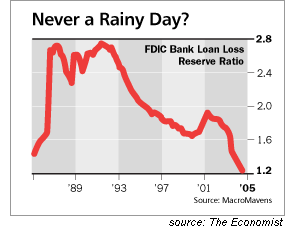 Astute reader Albert T. recently alerted me to financial issues such as the Basel II Accords
which, while being way over my understanding, seem to suggest that leverage--and thus risk--
is rising in the global banking system. I have commented previously on the vast expansion
of risk via derivatives, and the growing dependence of the banking sector on housing. Now
it appears that increased leverage is a global phenomenon, one that is easily buried deep
inside 10-Q statements. Here are some of Albert's comments (my emphasis in bold):
Astute reader Albert T. recently alerted me to financial issues such as the Basel II Accords
which, while being way over my understanding, seem to suggest that leverage--and thus risk--
is rising in the global banking system. I have commented previously on the vast expansion
of risk via derivatives, and the growing dependence of the banking sector on housing. Now
it appears that increased leverage is a global phenomenon, one that is easily buried deep
inside 10-Q statements. Here are some of Albert's comments (my emphasis in bold):
These two things are the most critical in my view IF the government allows amortization of goodwill there could be some of it that could seep into the capital ratios and make it possible for banks to be way more leveraged. Take any major bank and you could see that their leverage has been consistently going up.In other words: bank capital requirements, which are already low (see chart above), may drop even further, setting the stage for bank failures as foreclosure losses exceed unrealistically tiny loss reserves. Look out for 2008. Very interesting comments and speculation, Albert, on some very difficult and arcane topics. Thank you for bringing them to our attention. We have a winner! Reader A.S. correctly identified Friday's mystery location as the California Poppy Preserve, in the Antelope Valley near Lancaster, California (in southern California.) Thanks to everyone who sent in a guess! July 10, 2006 This Blog for Sale--But Not for $5  The MediaCentric column in BusinessWeek's July 10 edition describes a
pernicious trend in the blogosphere: saying nice things about corporate products
in one's blog
for a few bucks--as little as $5 or $10.
"Polluting The Blogosphere:
Bloggers are getting paid to push products. Disclosure is optional."
The MediaCentric column in BusinessWeek's July 10 edition describes a
pernicious trend in the blogosphere: saying nice things about corporate products
in one's blog
for a few bucks--as little as $5 or $10.
"Polluting The Blogosphere:
Bloggers are getting paid to push products. Disclosure is optional."
This calls to mind the old joke about the suave and wily gent asking a very attractive young lady if she would be willing to trade her favors for an evening in exchange for $1 million. (Yes, there was a movie made on this premise.) After the requisite blushing and stammering, the young lady allowed that she was indeed willing to entertain the offer. The gentleman then asked if she would be willing to provide the same service for $100. Outraged, the young lady demanded to know exactly what he thought she was. He replied, "I think we've established what's for sale. Now we're just haggling over the price." Longtime readers know that This blog sold out back in December 2005; but like the young lady in question, we don't come that cheap. 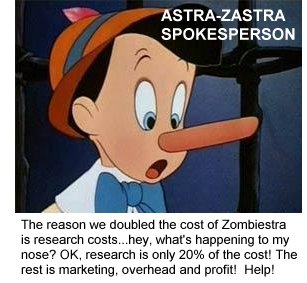 Yes, we have negotiated a very very generous
compensation package for placing corporate clients Kroika! Cookies, Astra-Zastra
Pharmaceuticals, Cervantes Beer and Jank Coffee on this site, but the deal comes with
this unique caveat: I get to trash and mock the brands and the products just as I did before
the marketing arrangement.
Yes, we have negotiated a very very generous
compensation package for placing corporate clients Kroika! Cookies, Astra-Zastra
Pharmaceuticals, Cervantes Beer and Jank Coffee on this site, but the deal comes with
this unique caveat: I get to trash and mock the brands and the products just as I did before
the marketing arrangement.
This keeps my site "respectable," as it were, because it maintains the appearance of being unbought. Clever, no? Rather like a young lady who very discreetly exchanges favors to a very few clients while maintaining a very modest, upright appearance, I have sold my soul--but for a good price. And I'm having fun doing so. The price is so good and the fun so swell, in fact, that I couldn't restrain myself from bragging about the arrangements. (See "Kroika Chronicles" and "Design Follies" in the lefthand sidebar for more.)  My latest ad venture reminds me of Sherlock Holmes' famous dog. Holmes and Watson
never owned a dog, of course, but in one of A. Conan Doyle's stories, Holmes remarks to
Watson that the dog's bark puzzled him. But the dog didn't bark, Watson exclaims. Yes,
replied Holmes; that's what's puzzling; shouldn't he have barked at the intruder?
Something was indeed amiss with the witness's account of events.
My latest ad venture reminds me of Sherlock Holmes' famous dog. Holmes and Watson
never owned a dog, of course, but in one of A. Conan Doyle's stories, Holmes remarks to
Watson that the dog's bark puzzled him. But the dog didn't bark, Watson exclaims. Yes,
replied Holmes; that's what's puzzling; shouldn't he have barked at the intruder?
Something was indeed amiss with the witness's account of events.
I am referring in a roundabout way to the discreet little ads which have been running the past few days at the end of each entry. Take a moment and scroll down to Thursday and Friday's entries, and look for the little text ads. You ignored them, didn't you? I know you did because I checked my web server's logs; not one visitor clicked on the "ads by Groogle" link. The ads looked like those ubiquitous "ads by Google" links, so you completely ignored them. Of over 2,300 visitors on those two days, not one clicked on the link. What does this say about "contextual" web ads? That they're completely ignored, and therefore a waste of ad money. Go ahead, click on the links, both of them. They won't bite. Then read this story from BusinessWeek on click fraud, and ponder just how bogus the entire web ad world might be, down to its very premise: that you the visitor will even notice the ads, much less ever click on one: Counting Up Click Fraud's Toll. NOTE: there are no real ads on this site, and there never will be. Get 900 miles to the gallon! Revolutionary technology now available! ads by Groogle July 7, 2006 Friday Quiz: Where Is This?  *
** * * * * * * * * * * * Like the two young sojourners in my little "road" novel I-State Lines, I prefer to camp when I drive across this amazing country. And one of the joys--or hardships--of camping is food. Everything tastes better over a campfire, especially if it's the end of the day or breakfast on a fresh new morning. This gives me an excuse to reprint a recipe for lighter-than-air pancakes which multi-talented reader Chris H. sent in response to my Gunnison National Park (Colorado) pancake story awhile back. Pancakes for Four:Sounds yummy, doesn't it? I guarantee these pancakes will taste better in camp than at home. I read somewhere that offering recipes is an excellent way to promote one's book--even if it isn't a cookbook--so in that spirit of formidable marketing prowess, I now offer you the recipe for the worst devil's ham sandwich ever made. This is from Chapter 20 of I-State Lines; the guys are running on fumes, out of gasoline and food, and they just got a job unloading drywall (sheetrock). Alex stares at the big stacks of sheetrock and says, "Brah, we can't work if we got nothing in the tank. Go get the grinds."So if there is a road trip in your plans this summer, why not order my little novel for something to read on the way, either in your motel room after a long day on the road or in your tent, after a hearty camp dinner. You can get the book pronto from my favorite online independent bookstore, The Kaleidoscope: Our Focus Is You (Shipping is free on all orders). Or if you have an open order at amazon.com, you can of course add I-State Lines Be the first to identify this specific park/reserve, and I'll send you a collector's copy of my book I-State Lines. So email me! (Hint: this gorgeous flower is the state flower of which state?) NOTE: as I will be away from my desk, there will be no entry on July 8. Insomnia and erectile dysfunction got you down? Buy Luna-Incubus cheap! ads by Groogle July 6, 2006 The Root Cause of the Housing Bubble (And No, This Is Not An Ad Parody) Here is an actual scan of a flyer I recently received in the mail. It neatly captures both the root causes of the housing bubble and its extreme precariousness. (Note: the formatting has been changed to fit this page.)  *
** * * * * * * * * * * * * * * * * * * This ad (and no, it is not a parody) reveals the complete abandonment of lending standards which has fueled the housing boom. As the flyer clearly states, It's almost impossible not to qualify. The ability of subprime borrowers to get a mortgage of $300,000 for less than $1,000 a month (not much more than the take-home pay of a minimum wage worker in California) with no down payment had the obvious effect of flooding the market with ready buyers. Classic economics predicts the result: when demand exceeds supply, prices rise. The ability to get a mortgage with no down payment created a new class of real estate investor/gambler. The siren song of rapid appreciation attracted many "investors"--about 40% of all new home purchases have been "second homes" or "vacation properties"--who were able to buy their second, third, fourth or fifth house with no money down. ("Flippers" may once again refer to someone flipping burgers rather than "investment properties," as the real estate flipper becomes the burger flipper.) 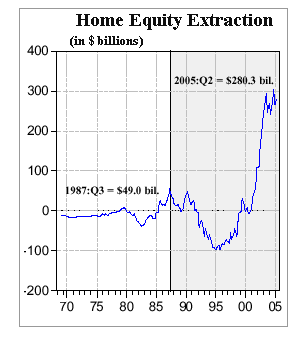 "Borrow up to 125% of the value of your home and take cash out for any purpose."
And those homeowners who needed extra money for college costs, vacations, remodels,
etc. found they could borrow vast sums of money via re-financing their home--and lower
their payment to boot once they accepted the rationale behind an adjustable rate mortgage (ARM):
interest rates will stay cheap while the value of your house will only rise.
"Borrow up to 125% of the value of your home and take cash out for any purpose."
And those homeowners who needed extra money for college costs, vacations, remodels,
etc. found they could borrow vast sums of money via re-financing their home--and lower
their payment to boot once they accepted the rationale behind an adjustable rate mortgage (ARM):
interest rates will stay cheap while the value of your house will only rise.
The asterisk by the teaser interest rate is a meta-message of sorts: it's telling you there is something fishy about the interest rate being offered. And we can all guess what it is: a big re-set in the near future. I eventually found the asterisked footnote on the back of the flyer in print so tiny I needed my photographic lupe to even read it. Yes, this is an adjustable rate mortgage which re-sets shortly to a much higher rate--like some 70% of recent loans in hot markets. Here are the actual terms of this amazing mortgage offering: "The payment examples are based on a fixed pay option ARM with a 30 year loan term and has a fixed initial payment based on a 1.00% minimum payment rate for the first year. The fully indexed rate is based on a fixed initial interest rate of 5.25%, 5.54% APR for the first 12 months and may increase or decrease after the fixed period."Do you reckon this makes perfect sense to an inexperienced new home buyer anxious to join the American Dream, or a newbie "flipper" anxious to join the automatic wealth generation machine of rapid appreciation? This goes a long way toward explaining the abundance of shocked and dismayed homeowners in news stories proclaiming their ignorance of re-sets which have taken their interest rate from 5% to 9%. The pundits predicting a "soft landing" in the housing market would do well to read this flyer carefully, and ponder what will happen to the millions of recent buyers when the re-set tsunami hits. If you couldn't afford to buy the house with a 20% down payment and a legitimate fixed-rate loan, then you won't be able to hold onto said house when your loan payment goes up 50% or even 100%. As I have said here before--what happens to prices when millions of ARM buyers can't make their payments and suffer foreclosure? Classic economics has the answer: when supply exceeds demand, prices drop. Please review previous entries listed under "Housing Bubble Watch" in the lefthand sidebar. Visitor Data This modest outpost on the World Wide Web recently received its 100,000th visitor this year-- small potatoes on the Web, to be sure, and very small potatoes in a blogosphere in which many blogs receive a million visits a month. Since starting this "no brands, no ads, no money" blog a year ago, the visitor count has climbed far above my minimal expectations. Thank you, dear reader, for your readership. I continually strive to post "original content" worthy of your scarce time. Your forgiveness when I don't make the grade is much appreciated. That's the risk of "no brand": you might arrive hoping for some gritty housing bubble analysis and find, to your dismay, a review of a foreign film or even worse, a dumb ad parody. For data freaks such as myself, here are the numbers: Month visitors visits Pages Hits Bandwidth Jun 2005 1,402 1,856 6,401 21,729 180.46 MB Dec 2005 2,887 4,659 11,769 39,404 517.16 MB Mar 2006 9,399 14,429 40,251 408,283 5.69 GB Apr 2006 19,449 41,510 99,594 569,808 7.36 GB May 2006 33,246 78,448 154,073 909,886 10.02 GB Jun 2006 30,029 63,548 141,489 937,516 11.12 GB While the visit count has receded from a spike in May (the result of numerous links to housing bubble stories, I guess), the bandwidth keeps rising, suggesting visitors are pulling more content off the site despite being somewhat fewer in number. (data courtesy of awstats.) If this exasperates you, I suggest obtaining a prescription for Zombiestra --"Because life's a beach" (TM) (brought to you by Astra-Zastra: "We came to do good but stayed to do well.") Buy a $450K house for only $750K ads by Groogle July 5, 2006 Bankruptcy U.S.A.: Medicare, Greed and Collapse 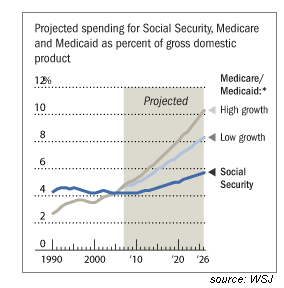 Knowledgeable reader W.N. sent in this account of just how disconnected from fiscal reality--
and responsibility--our Medicare system has become: (my emphasis in bold)
Knowledgeable reader W.N. sent in this account of just how disconnected from fiscal reality--
and responsibility--our Medicare system has become: (my emphasis in bold)
"I witnessed a series of events not long ago that fairly bludgeoned me over the head with all the weight of exactly why our National Debt has spiraled out of control.As the chart above reveals, here is the very definition of a system running headlong toward the cliff of national bankruptcy. People with millions in assets pay virtually nothing (if your income flows from investments, you pay zero into Medicare--that's only for wage slaves and the self-employed), while the bills are paid with borrowed money. (Much of the stupendous Federal Deficit can be attributed to skyrocketing Medicare costs and that gift to the Pharmaceutical industry, the Medicare Drug Plan.) 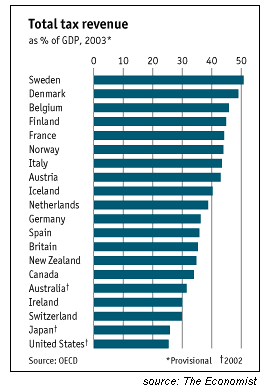 Meanwhile, who benefits from such an abjectly unfair system in which the rich pay nothing
for their own medical care? Their heirs, of course--the Greediest Generation, the Baby Boomers.
Meanwhile, who benefits from such an abjectly unfair system in which the rich pay nothing
for their own medical care? Their heirs, of course--the Greediest Generation, the Baby Boomers.
Here is the chart of complete fiscal irresponsibility. We all want gold-plated, top-notch $250,000 per person medical care, yet we also want the lowest tax burden in the world. Uh, do you see the disconnect? We as a nation are living in a childishly short-sighted, utterly illusory world in which galloping medical care costs can be paid with borrowed money forever--the bill will never come due, at least in our lifetime. Nice--but what about our kids and grandkids? The Greediest Generation doesn't give a fig about future generations--their sights are set on inheriting Mom and Dad's wealth in its entirety--never mind paying for Mom and Dad's medicare care. Low taxes and gold-plated medical care for all! Deficits don't matter! (Thank you, Mr. Vice President, for perfectly capturing the ethos of the Greediest Generation--deficits don't matter, because I'll be dead when the bill comes due. Hahahahahahaha!) There is another way: require people to pay for their own medical care if they have any assets. "Pay your own way"--is that really so morally reprehensible? I can state categorically that this is possible, because my Mom just paid for her lifetime care, in cash. She sold her house, took her entire equity (about $150,000 or so) and used that money to buy into a lifecare facility. That lump sum (plus monthly fees, of course) enables the church-run facility where she now lives to fund the care of its residents for their lifetimes. You see what's wrong with this: her heirs (me and my brother and sister) don't get a dime of her home equity. And we couldn't be happier. Why, it's an outrage! Don't we deserve to inherit every dime of her assets, without a single dime of taxes being paid? Why didn't she scam the system by giving us the house five years ago and then throwing all her care expenses on the government? Boomers--and their spineless lackey politicians--grow up. You don't deserve your parents' wealth. They should pay their own freight in life, and so should you. Pay your own way. It's fair, it's affordable, it works. I weep for a nation so greedy and blind to the burdens it places so thoughtlessly on its future generations. July 4, 2006 Birth of the U.S.A.--The Alternative Version The Scene: Three Founding Fathers (FF) sit glumly around a small table in the flickering light of a guttering candle. FF1 Houston, we hath a problem. FF2 Great Scott, man, must you speak in confounded riddles? FF1 Truly, my speech amazes me as much as you. The phrase seemed to have uttered itself. I meant only to say that we are in deep muck. FF2 You refer, I believe, to the polling numbers in Maryland and Massachusetts? FF1 Precisely. Independence has been polling exceedingly poorly. In some burgs, some 40% of the populace prefers to remain subjects of the King. FF3 Why, the running curs of Monarchy! A Pox on their wretched selves and their miserable possessions! FF1 You speak of our countrymen thus? I fear for the Revolution if that be our stance. FF3 And what do you suggest as an alternative, Sir? FF1 It occurs to me that perhaps an incremental approach would convince our doubting brethren. Perhaps we could try publishing broadsheets and posting them far and wide, carrying a message of conciliation. FF2 Ah. Then, we re-poll the populace to ascertain if our numbers be rising? FF1 Precisely. If our numbers have thus risen, then we could reshape our message to one of Revolutionary Reconciliation. FF3 What mealy-mouthed drivel is this? How can reconciliation with the powers of Monarchy and repression be revolutionary? FF1 But dear Sir, look at the numbers. Some 20% of our brethren state they would actively take up arms in defense of the Monarchy. Do we engage in civil war? FF3 If we must fight our countrymen to throw off the shackles of the King, so be it. FF2 Alas, my friend, you go too far. Let us seek better polling numbers before striking such a risky stance. FF1 Yes. We cannot act until we poll above 70%. FF3 (Sighing heavily). Then the Revolution is off, as is liberty and freedom. But I must say, by thunder, a pox on the polls! Give me liberty or give me death! I have not yet begun to fight! FF1 Verily, but we dare not act by conscience and conviction alone. We must poll, poll, poll, and await the support of the great majority. FF3 Then we accomplish nothing in this lifetime, or the next. God help such a spineless people as ourselves. A sudden gust of wind extinguishes the candle, and the three men sit in profound darkness and silence. July 3, 2006 Whither the Dollar and Interest Rates? Note: I heartily recommend enjoying your morning dose of caffeine before tackling this entry...  Astute reader LJR offered this counterpoint to my argument that long-term-rates (and hence
mortgage rates) will rise even if the Fed tried to re-inflate the housing bubble by
dropping short-term rates. My reasoning hinged on the fact that rising inflation will
erode the real (inflation-adjusted) yield of long bonds, forcing foreign buyers (a major source of funds) to demand
higher interest rates, regardless of short-term declines in rates. LJR provides an explanation
of how long-term rates may well decline in response to a drop in short-term rates (my emphasis added in bold):
Astute reader LJR offered this counterpoint to my argument that long-term-rates (and hence
mortgage rates) will rise even if the Fed tried to re-inflate the housing bubble by
dropping short-term rates. My reasoning hinged on the fact that rising inflation will
erode the real (inflation-adjusted) yield of long bonds, forcing foreign buyers (a major source of funds) to demand
higher interest rates, regardless of short-term declines in rates. LJR provides an explanation
of how long-term rates may well decline in response to a drop in short-term rates (my emphasis added in bold):
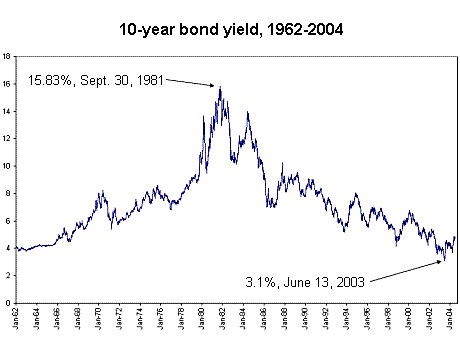 *
** * * * * * * * * * "For the sake of argument, when the Fed reduces short term rates the commercial banks borrow short and lend long using derivatives to contain the risk. By lending long they drive down long-term rates even if the foreigners don't continue buying.Well said, LJR--lots of substantive food for thought here, for the dollar and interest rates are indeed a puzzle worthy of Mr. and Mrs. Charles. (see my review of The Thin Man series under "Writing/Film" in the left sidebar.) I am still not convinced that inflation won't play into long-term interest rates in some fashion despite the arbitrage between short and long-term rates--after all, if inflation has entered a 15-year up-cycle, why wouldn't bonds follow suit?--but we'll see how that plays out in the months ahead. Those interested in the thesis that the essential goal of U.S. fiscal and foreign policy is to maintain the dollar as the primary (global) currency in the oil market, please read The Real Reasons for the War in Iraq by William Clarke. (Recommended to me by reader Harun Ibrahim; please see July 1 entry.) It is a stimulating read. Even if you absolutely disagree, and find this overwrought or wrongheaded, the consequences of the dollar being even partially supplanted by a competing currency as the global "coin of the realm" is worthy of serious consideration. We have a winner! Reader J.H. correctly identified yesterday's location as Kahala Beach, Oahu, Hawaii, with Koko Head and Portlock in the distance. The best "good fun" entry came from reader T.K. who wrote: "That obviously is North Ave. Beach, complete with the downtown Chicago skyline in the background. Lake Michigan has never looked better!" Mahalo plenty, T.K., fo' da big-kine laugh. July 1, 2006 Sucker's Rally Several readers have commented on my May 6, 2006 prediction that the stock market would decline precipitously starting May 11--which it promptly did (see Is the Stock Market on the Same Planet as the Economy? Obviously Not, May 6) Astute reader Harun Ibrahim recently shared what is clearly a knowledgeable trader's view of the stock market's recent rally. Your call about the market decline was interesting. I saw it coming from the perspective that Commercial traders were establishing large net short positions in Dow futures for some time. Ahead of the Fed Commercial traders increase positions net short from 21% to 54% (largest percent net short position in 10 years), Large traders increased 7% to 17% net long, and Small traders (generally the public) increased 14% to 37% net long (largest percent net long position in 10 years).In other words, while the smart money exited, the retail "investors" piled in-- just what I had surmised back in May. It's instructive to look at a chart of the Nasdaq market over the past 5 years. Note that the uptrend line from October 2002 has been decisively broken. 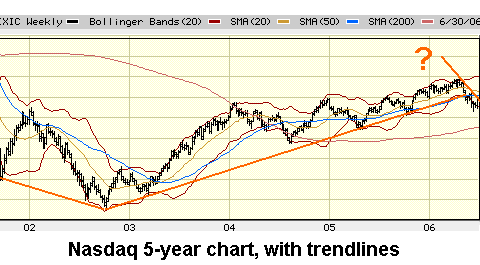 *
** * * * * * * Mr. Ibrahim was kind enough to send me two detailed spreadsheets of COT data and charts to support his comments. So please take note: the market is not "transparent, rational and a level playing field" as per the rah-rah Wall Street hype; that's just part of the con. If you want to "invest" (i.e. gamble) in the stock market, it's best to heed those with the analytic skills, skepticism and experience which Mr. Ibrahim clearly possesses. For what it's worth, an excerpt from my May 6 entry: Here's the real reason for the stock market's fairyland climb: Bubble follows bubble follows bubble. As the Dot-com stock bubble expired, dropping the NASDAQ from 5,300 to 1,100, the psychology of the Free Lunch--money for nothing but playing with money--transferred seamlessly to the real estate market, driving it to unprecedented classic-bubble heights. As this "free lunch money" (all $2.5 trillion of it) gushed into homeowner's pockets, about 2/3 was spent (according to Fed estimates cited in previous entries) but some flowed into other investments such as the resurgent stock market.Mr. Ibrahim also sent along a fascinating and deeply disturbing essay entitled The Real Reasons for the War in Iraq by William Clarke. The thesis is this: the U.S. must keep the dollar as the world's only commercial and reserve currency, and the war essentially serves that goal. More on this and the dollar in future entries. June 30, 2006 Where Is This?  *
** * * * * * * * * * This is what's known as "sharkbait"--tasty white meat on a beach somewhere, looking unhealthily pale. So where is this sharkbait standing? Alas, the paleness is genetic and cannot be fixed by frolicking in the sun. Note the hat and late hour of the day (scars from skin cancer surgeries are not visible, thank goodness). And yes, that is SPF 40 on the sharkbait skin. My surfer friend G.B. turned me on to Aloe Gator Total Sunblock Lotion, and it really is waterproof. This location is just too easy for those residing in a certain state whose name shall go unmentioned, but visitors may not have wandered down to this largely ignored (and therefore peaceful) strip of sand. At the nadir of my starving student days (i.e. emptying my childhood coin collection to buy a couple gallons of gasoline for my crummy VW Bug), I lived just a few blocks from this beach in a guest cottage stuffed with the owner's business records. I literally had to thread my way through stacked boxes of tax records to get to the tiny bathroom. But the price was right and I managed to survive the recession of 1973-74. (This practise will help me survive the recession of 2007-11.) Typically I pitch my little novel I-State Lines on Friday, but since yesterday's subliminal campaign failed utterly, I am too despondent to even work up a pitch. Instead, let's get another perspective on "paying for Web content" from an akamai correspondent who had this to say regarding my recommendation to subscribe to patrick.net's new fee-based service (see yesterday's entry for context): Really? $75 a year for a page full of links that other people send him? Hardly seems like original content, or time-consuming either. The stuff you write is 10X more creative than a simple "link farmer" assembling a list of pages based upon what other people send him. Heck, the entire content of the WSJ online is $79/year. I would subscribe to patrick.net for something like $10/yr, but $75 no way, just out of principle - there's no creativity involved whatsoever. Heck, next month, someone else (maybe me) will start compiling links of housing stories.I think the source of irritation is clear--assembling links does not qualify as original content to this reader, and I can understand that view. The Web is littered with failed attempts to get users to pay for content, and I am not sure that the current fad of placing contextual ads on sites will succeed in the long run, either. That doesn't stop me from trying it, too, of course. So twist your doctor's arm into writing a prescription for Zombiestra (TM), "Because Life's a Beach" (TM, Astra-Zastra). See how that works? I mentioned "beach" in today's entry, and my handy-dandy ad placement script quickly identified this as the perfect time to insert Zombiestra's catchy slogan, "Because Life's a Beach" (TM). Be the first to identify this specific beach, and I'll send you a collector's copy of my book I-State Lines. So email me! To view entries in June, go to weblog June 2006. Please browse this month's entries and the archived wEssays listed in the sidebar. If nothing here strikes your fancy, skim through my recently published articles (generally in the San Francisco Chronicle) and my archives back to 1995. I would be honored if you link any essay to your website, print a copy for your own use or add my RSS or Atom feed. And of course I appreciate your recommendations of this weblog and your comments: csmith@oftwominds.com. wEssay noun, combination of 'web' and 'essay,' denoting a short online essay which exploits the hyperlinks, interfaces and interactive capabilities of the World Wide Web; coined by Charles Hugh Smith on May 1, 2005, in Berkeley California. copyright © 2006 Charles Hugh Smith. All rights reserved in all media. |
 |
Subscribe via RSS: search my site:
Worth Visiting:
Mish's Global Economic Trend Analysis Marin Real Estate Bubble View from Silicon Valley Rick's Picks Gold Eagle Econotech ilind.net myrealestate bubble.com articles and eBook and blog John Francis Kinsella author/painter The Kaleidoscope (indie bookstore, free shipping; buy my novel I-State Lines) |
|||||||||||||||||||||||||||||||||||||||||||||||||||||||||||||||||||||||||||||
|
Our retail policy: Nothing is for sale except books/films I recommend and my own novel I-State Lines (via links to Amazon.com and The Kaleidoscope: Our Focus Is You independent bookstore) Free alternative: find them at your local library. |
home |